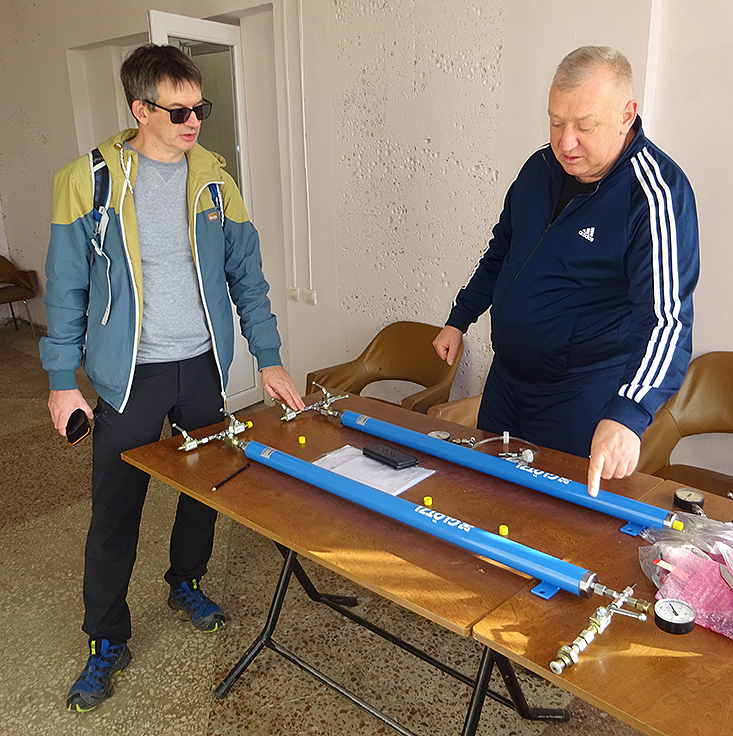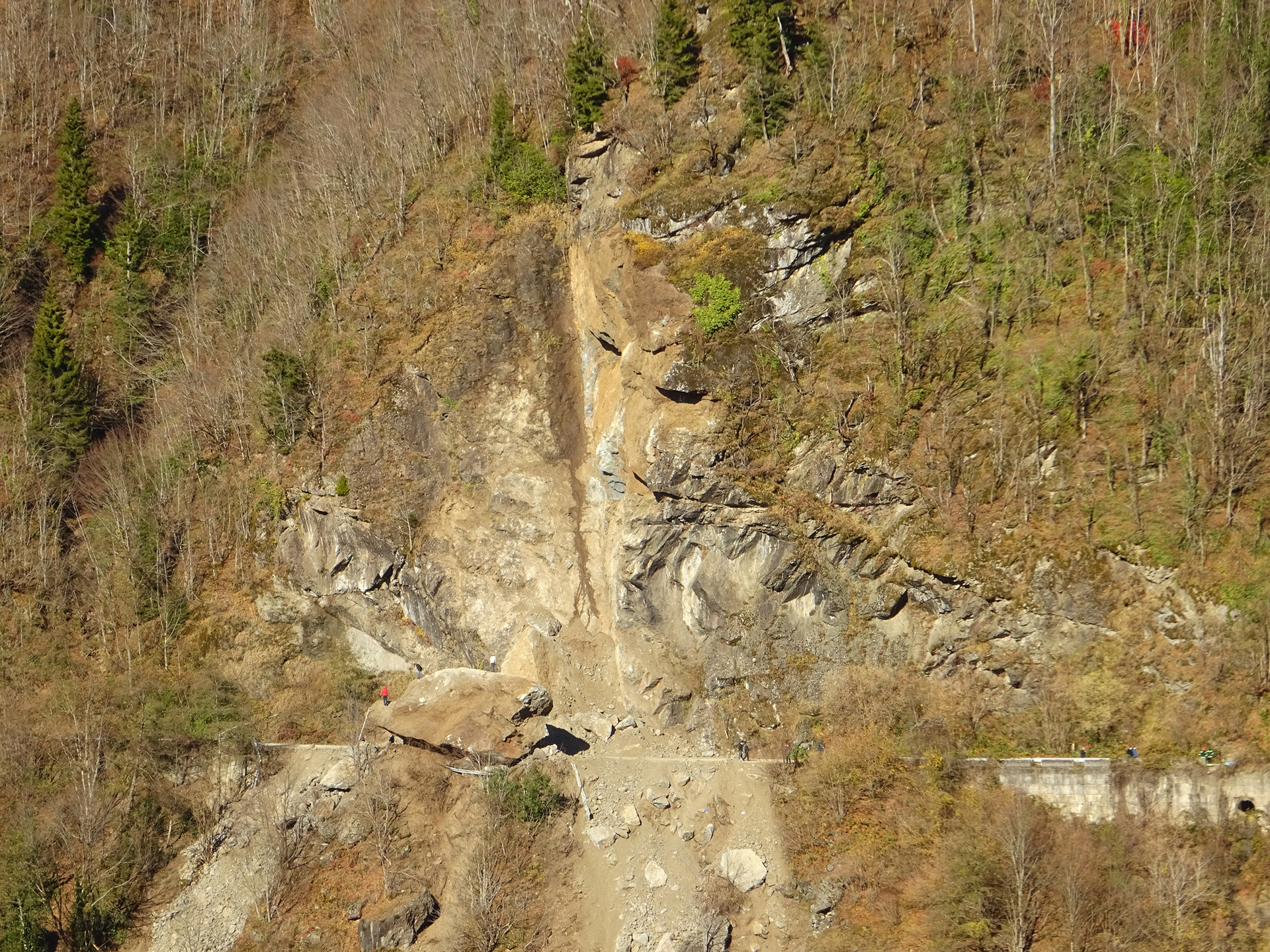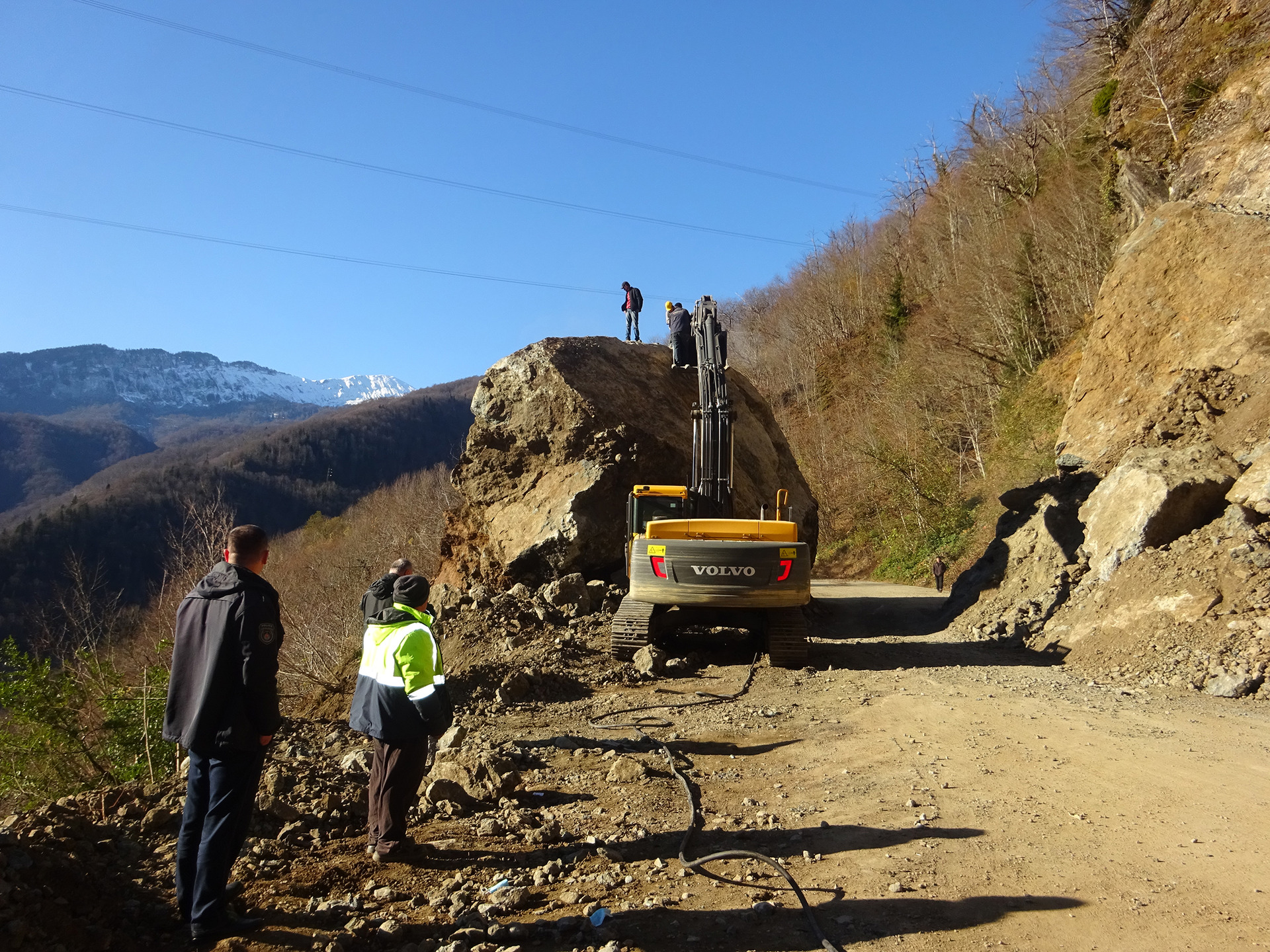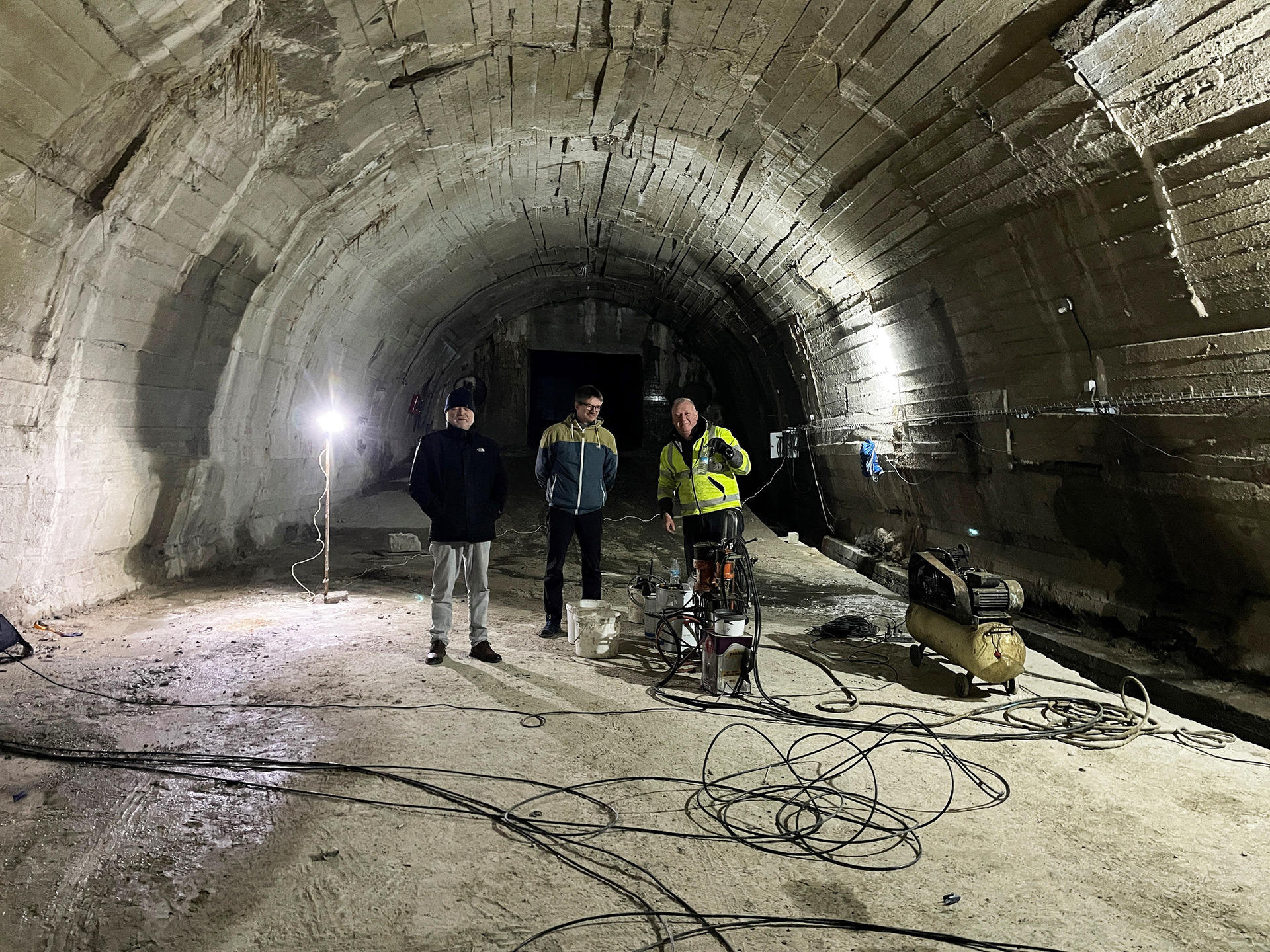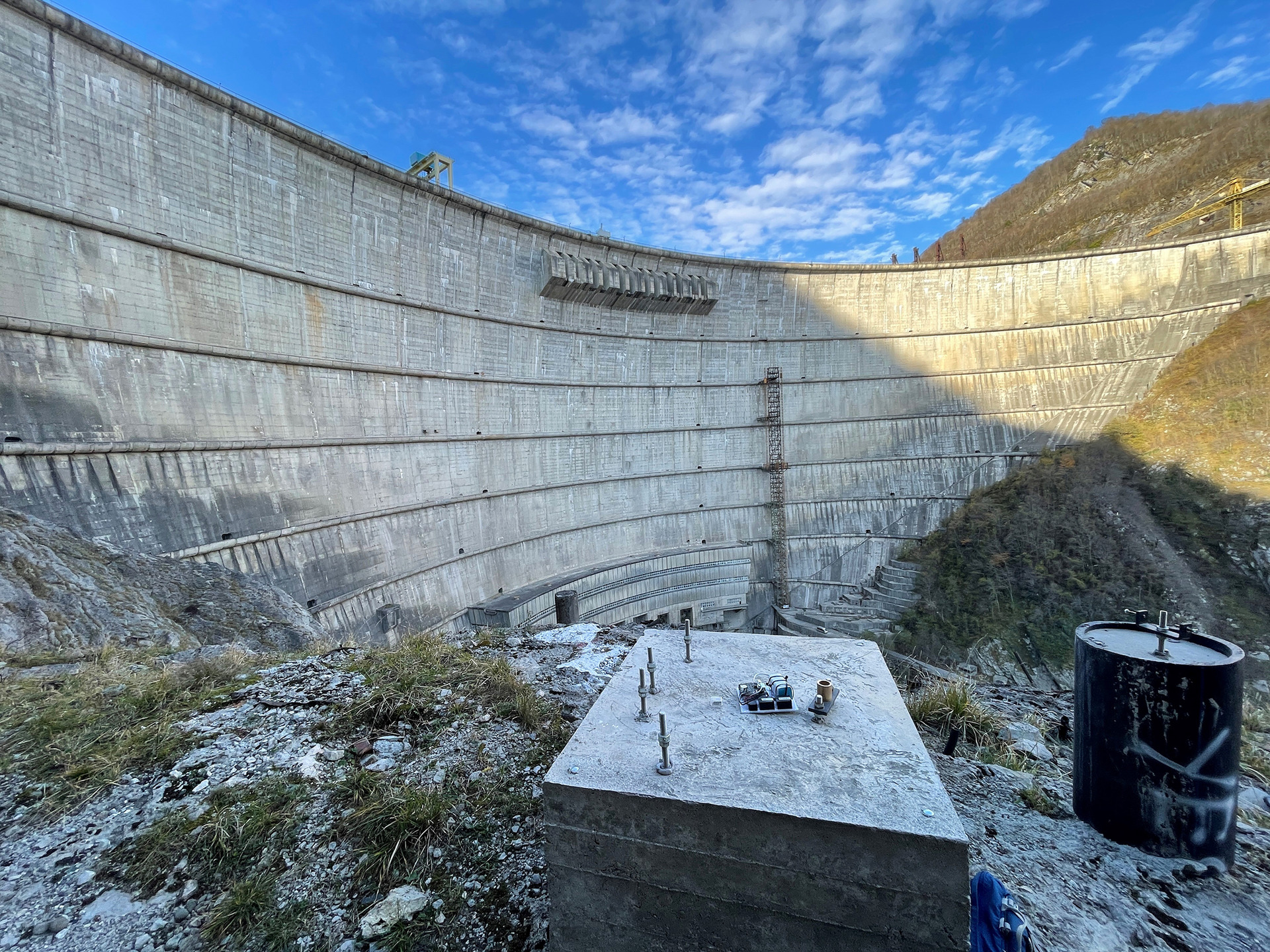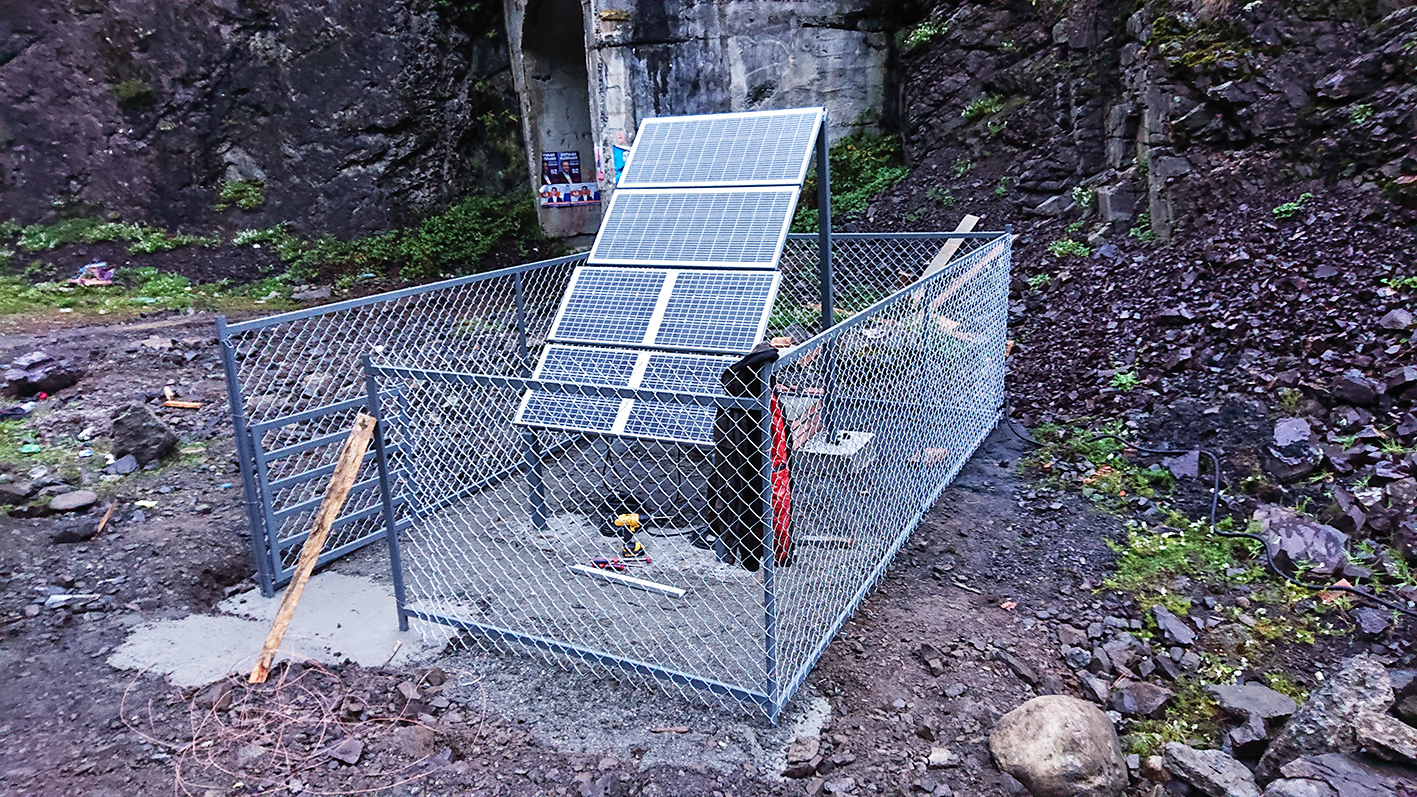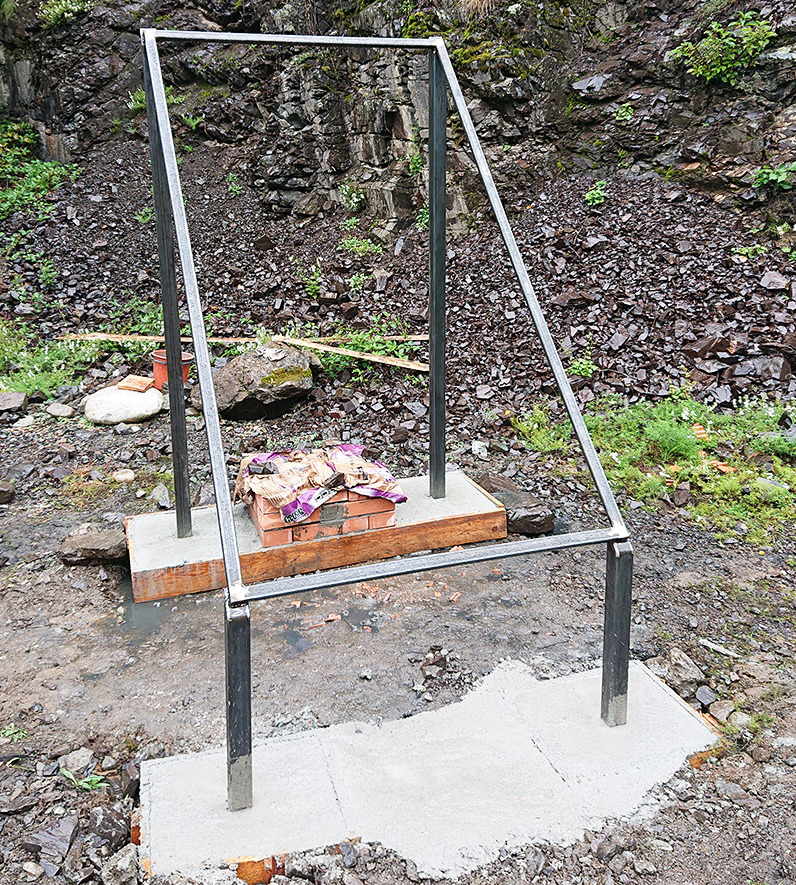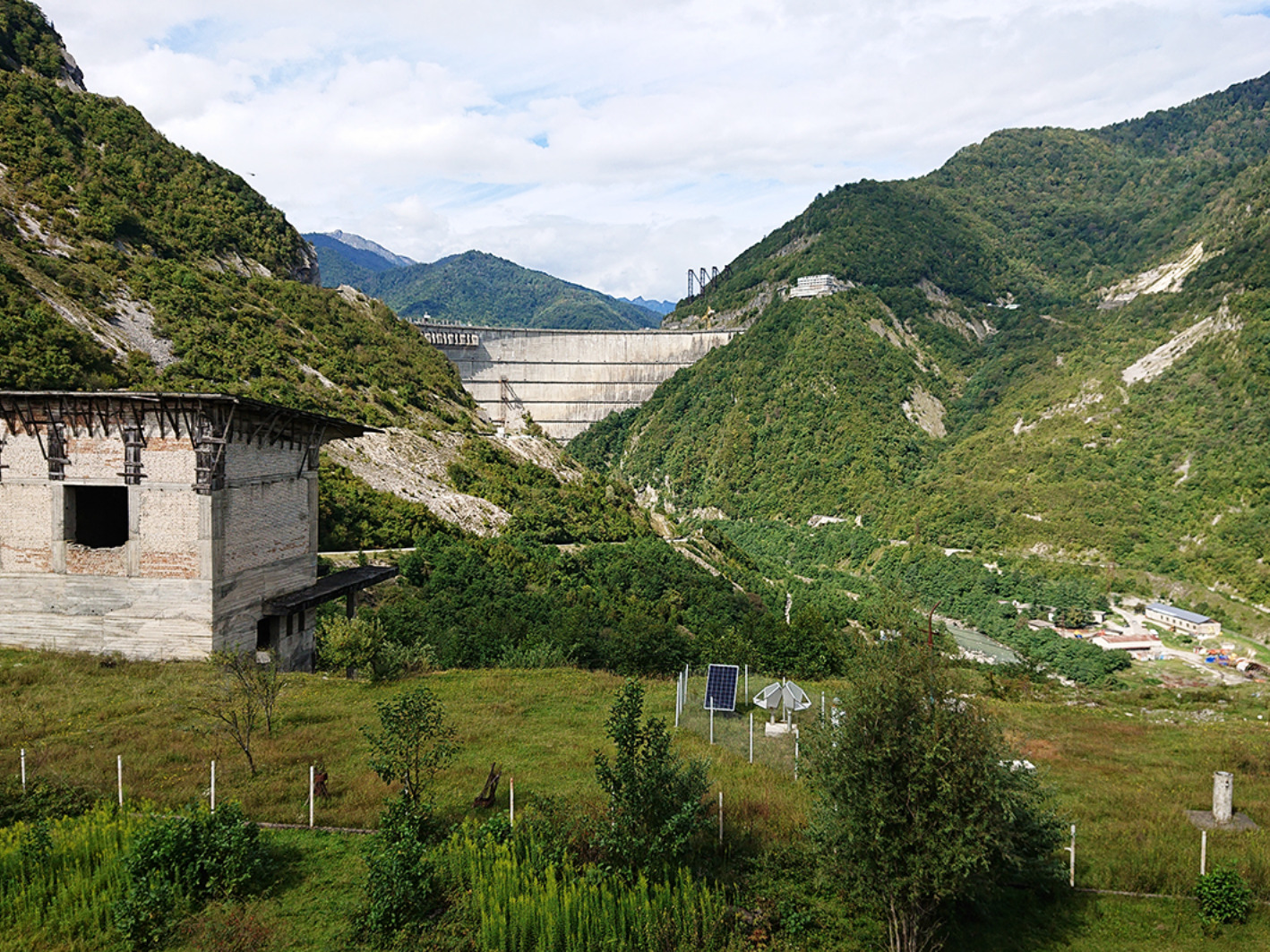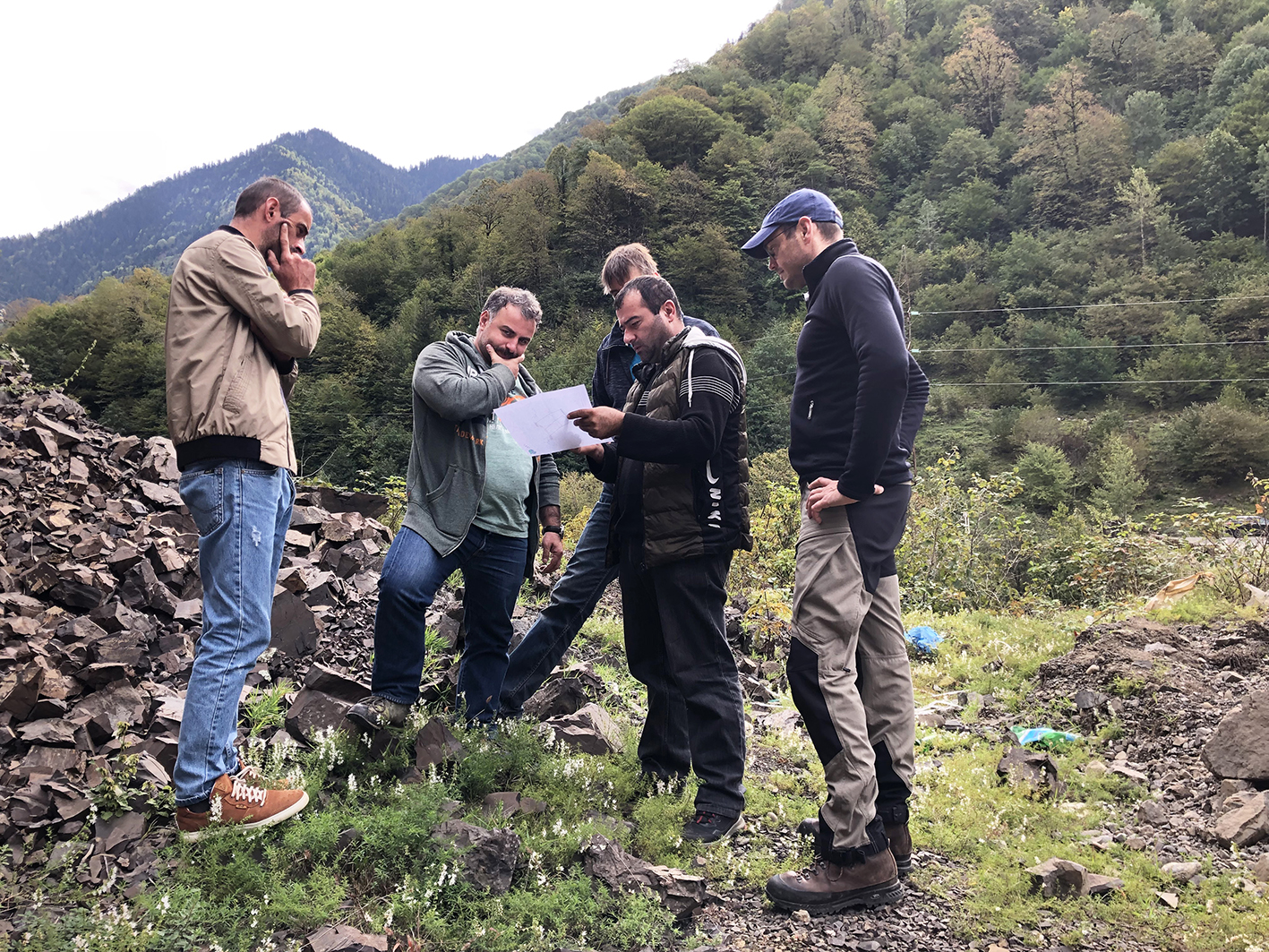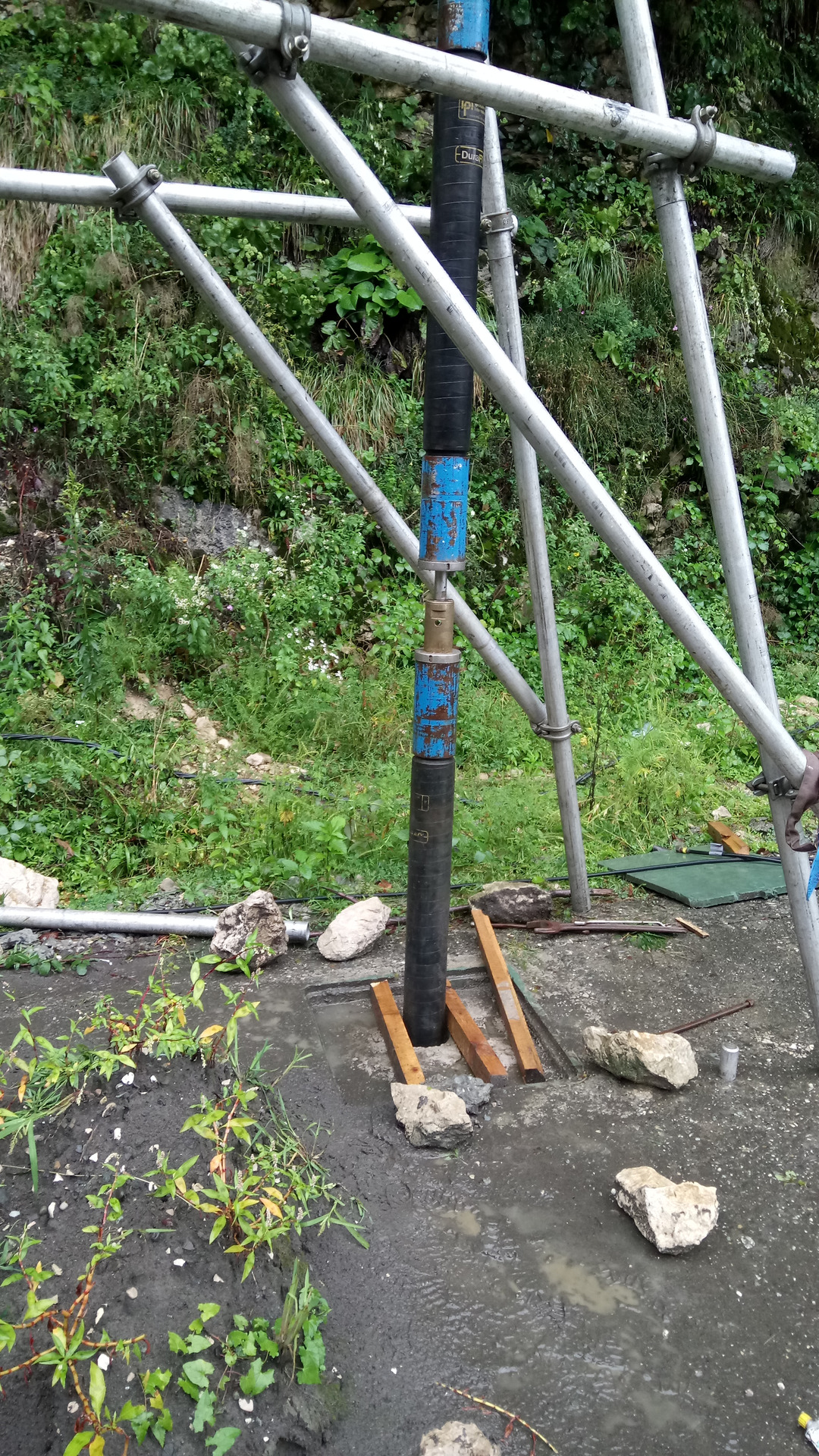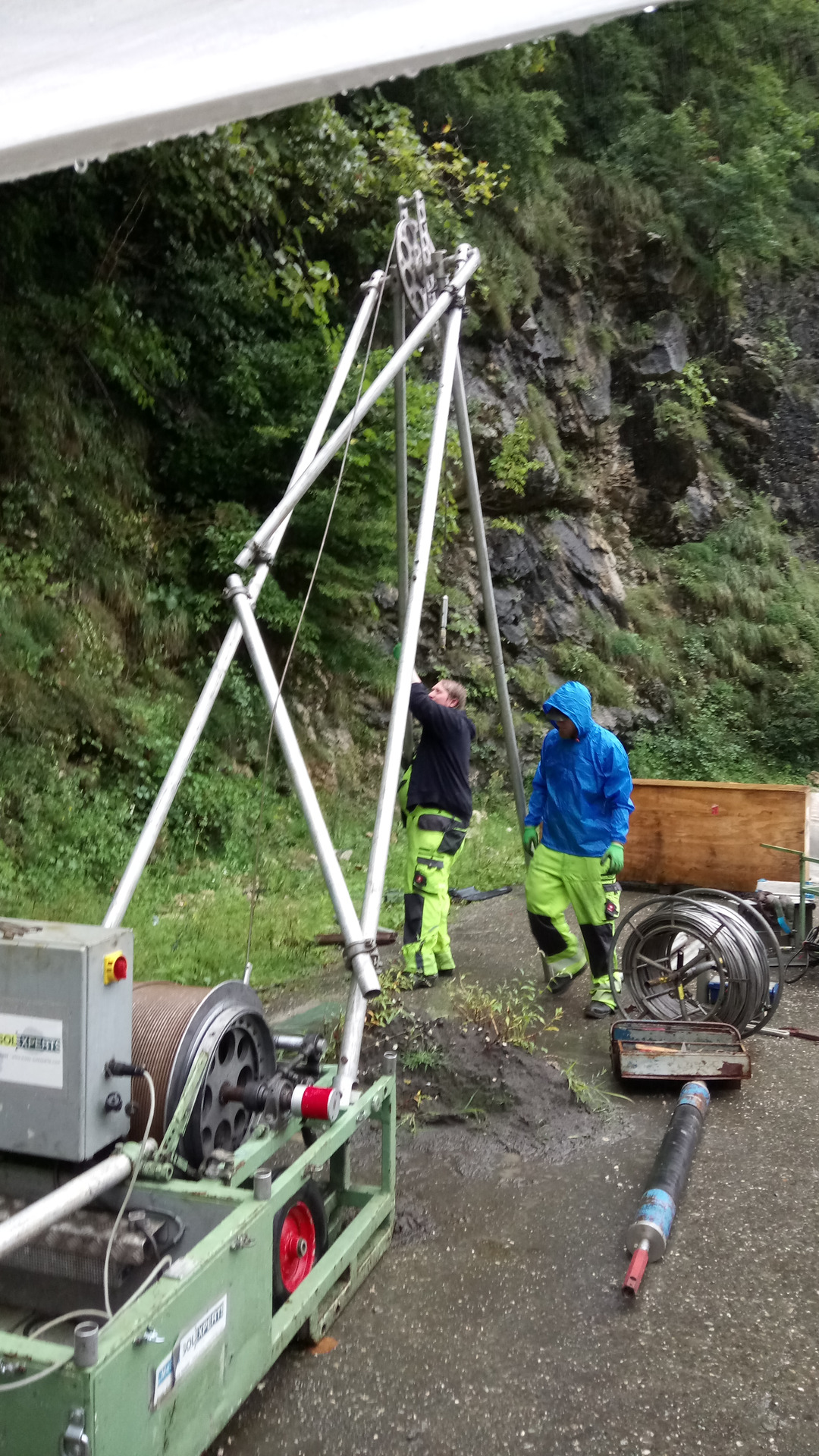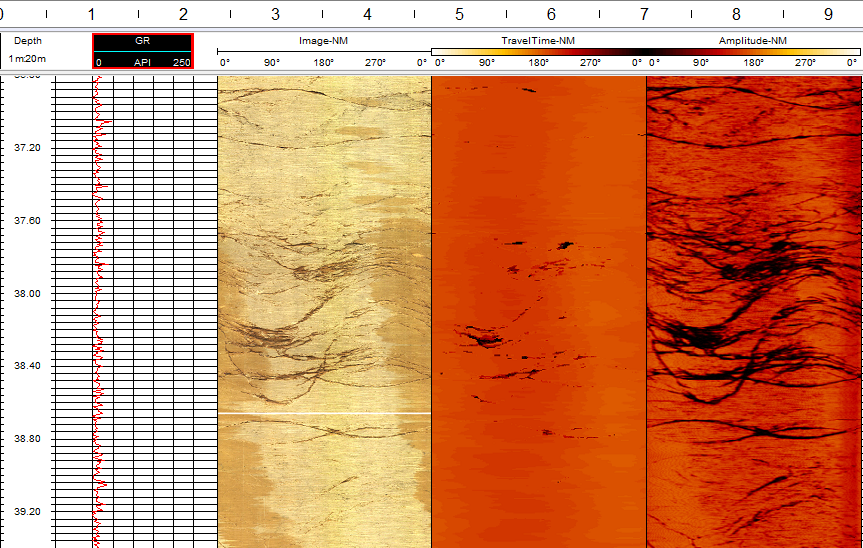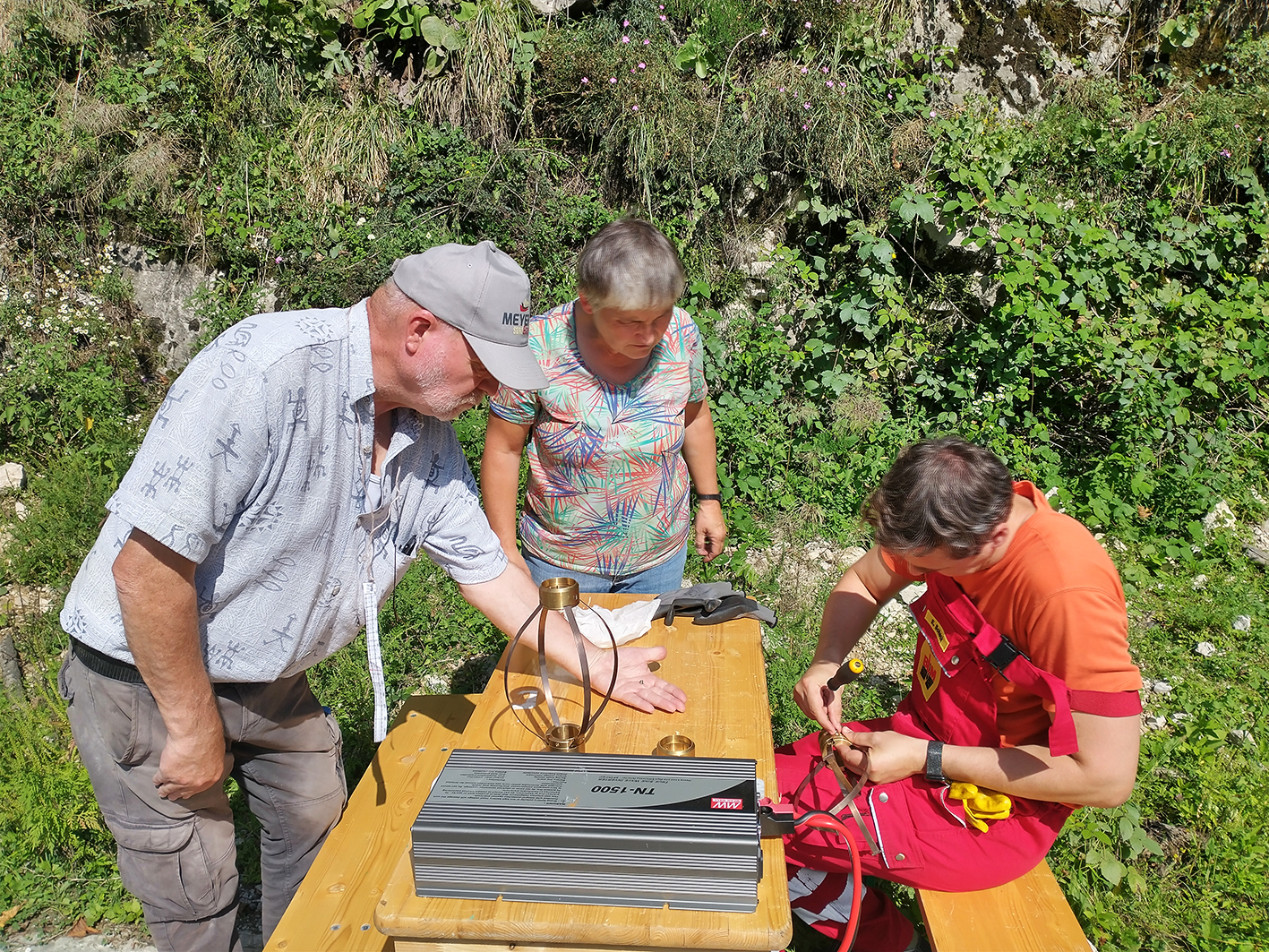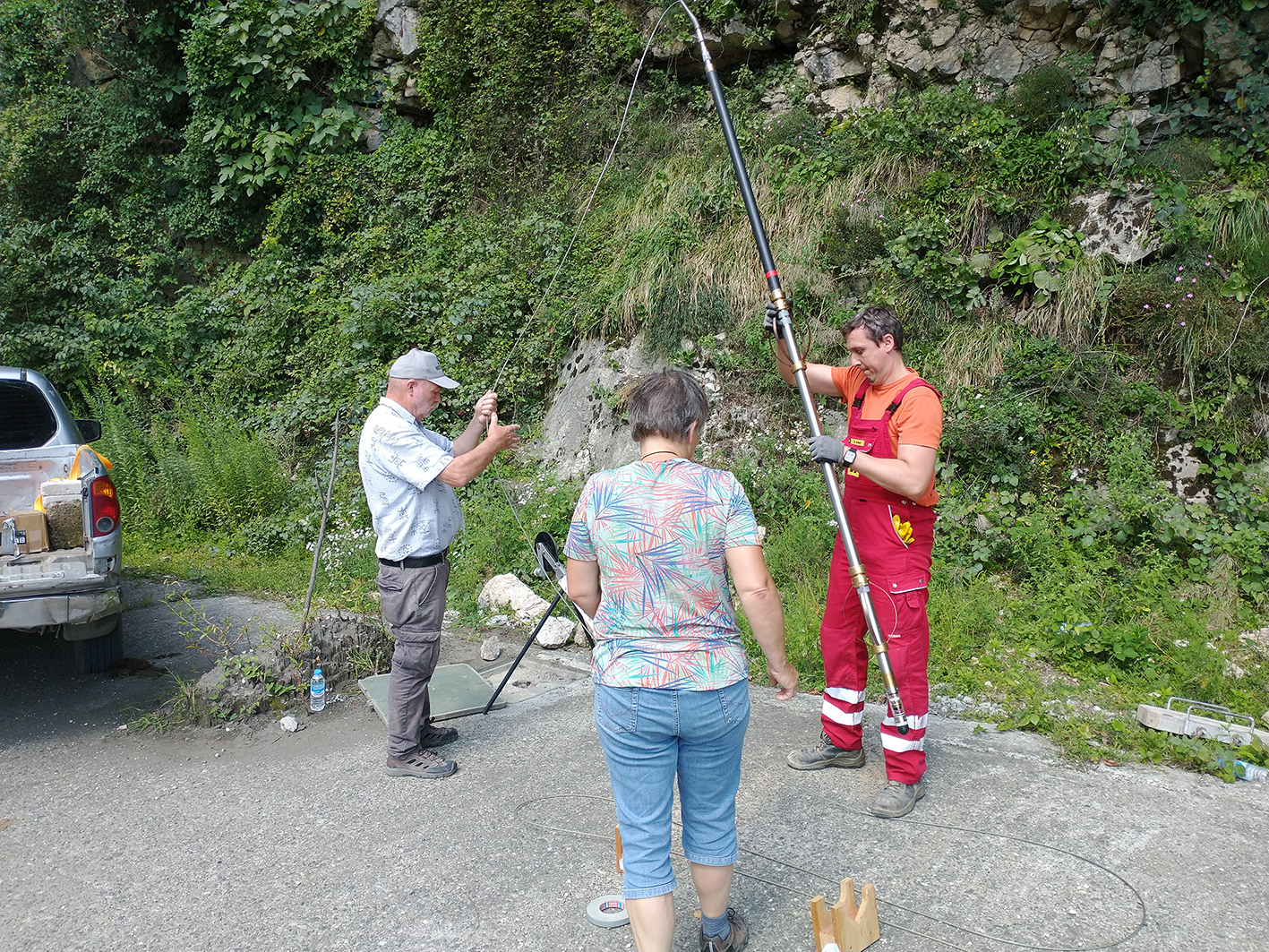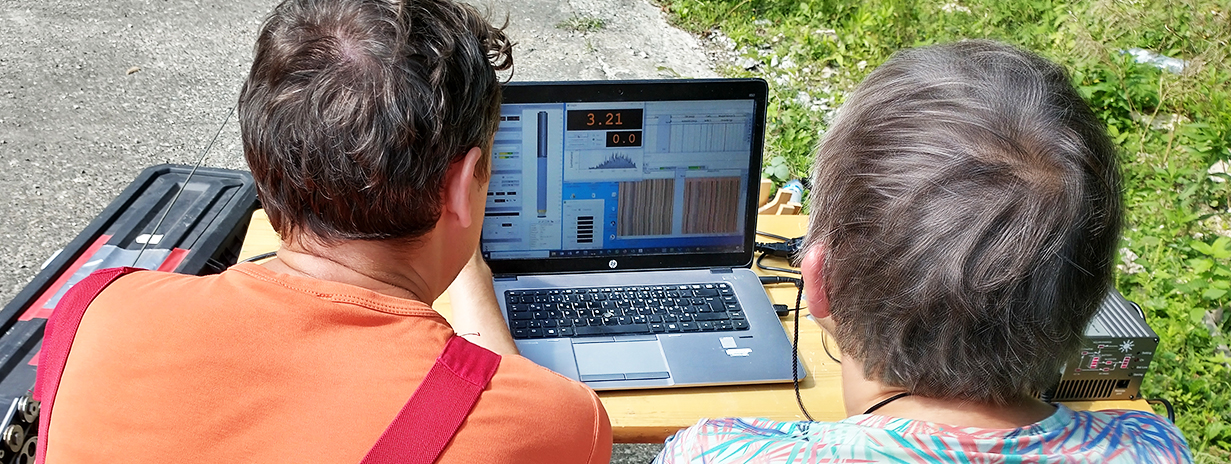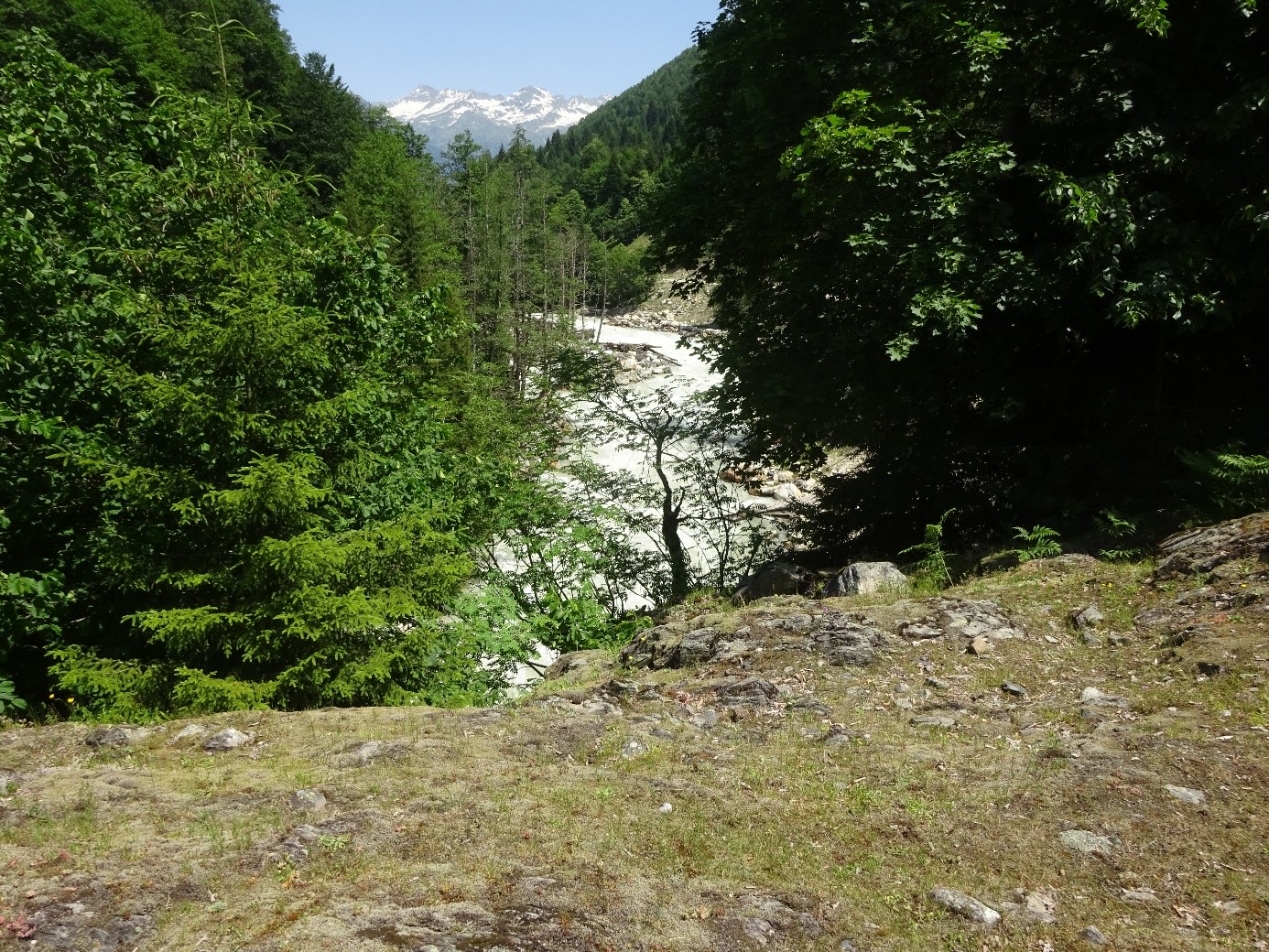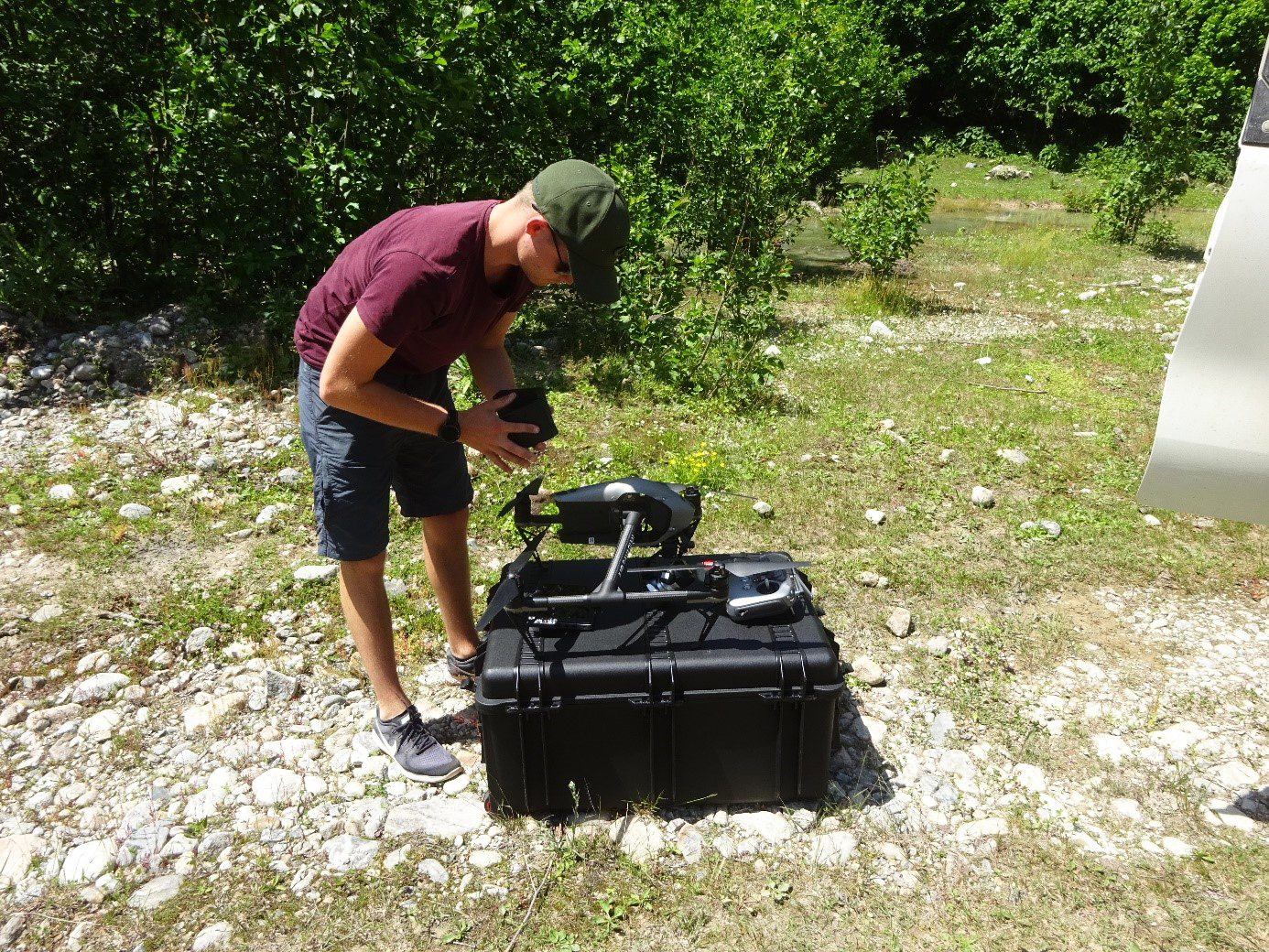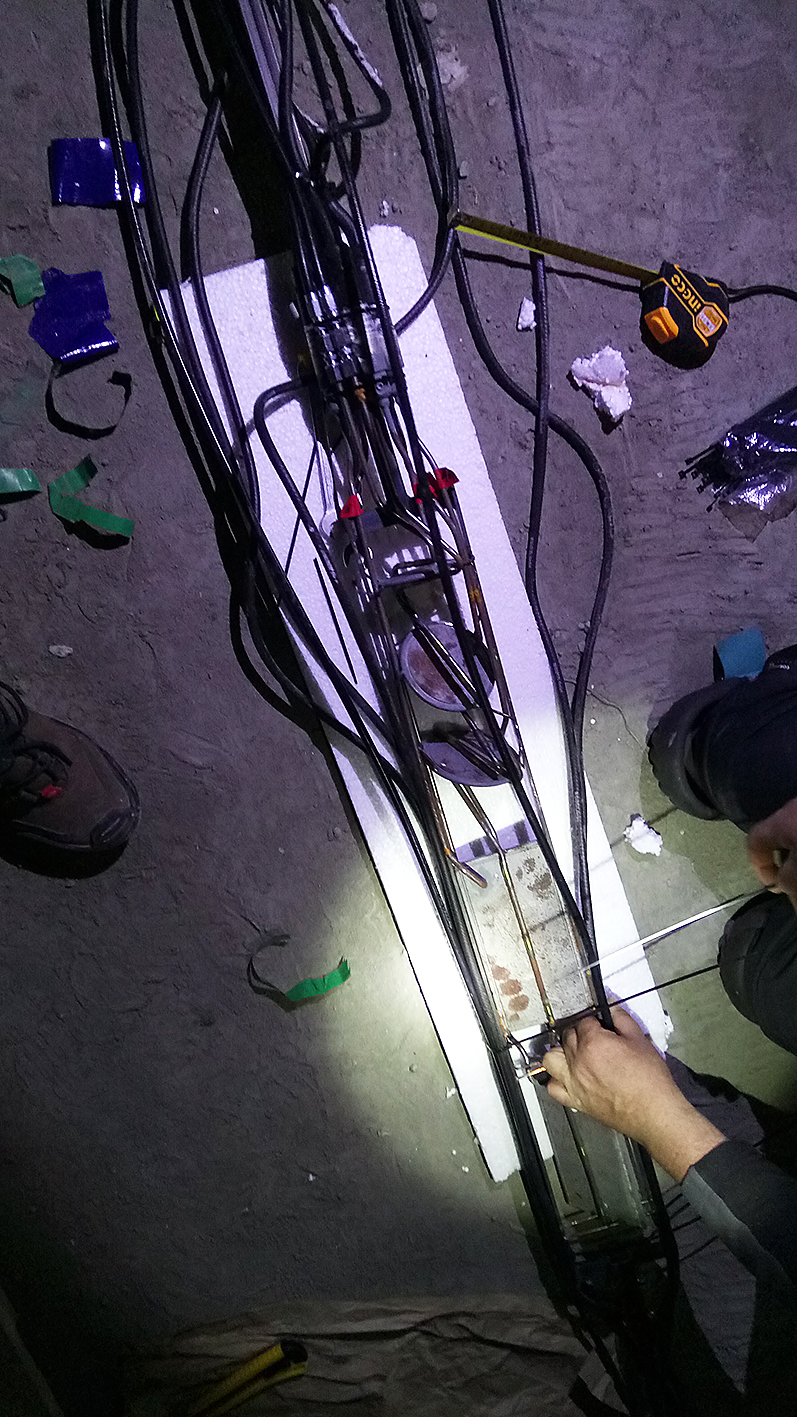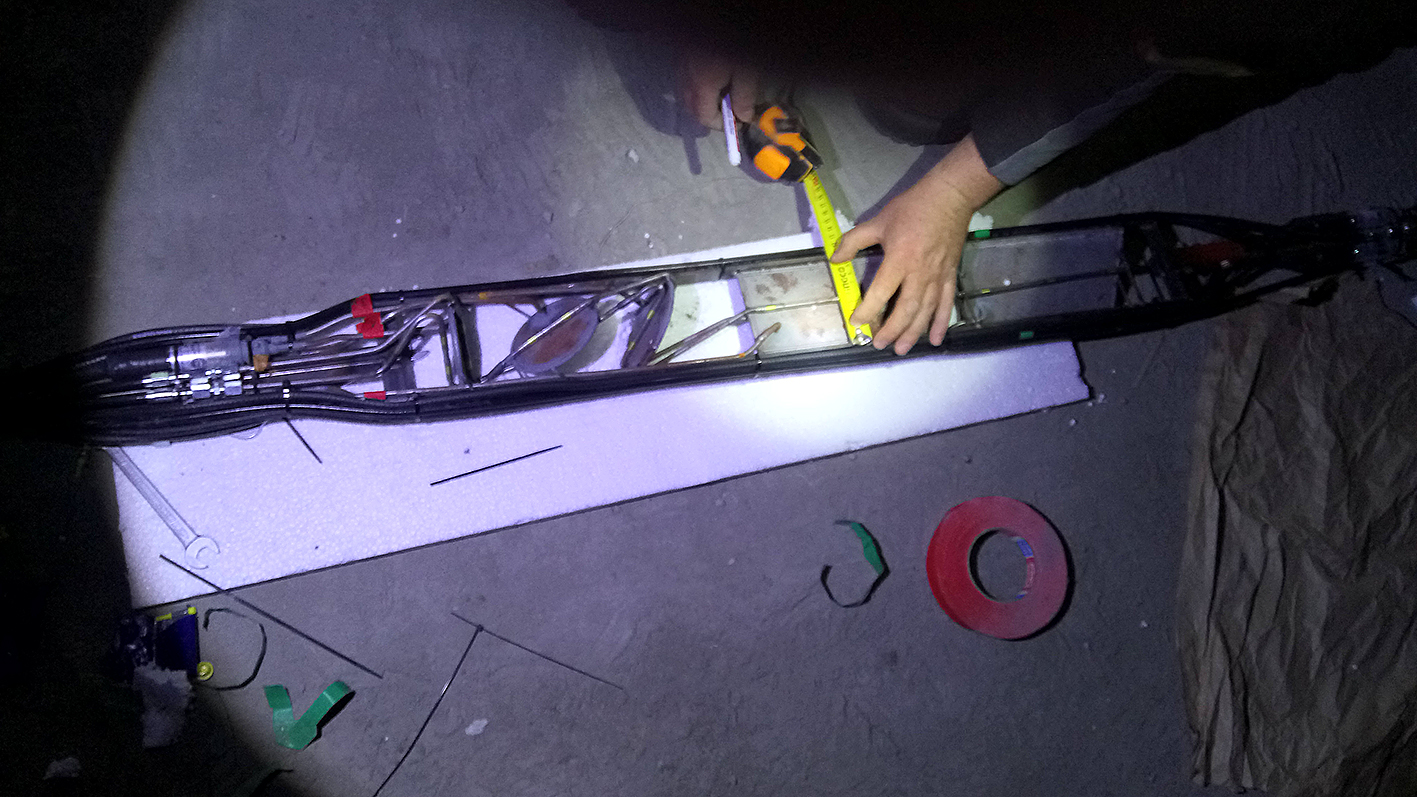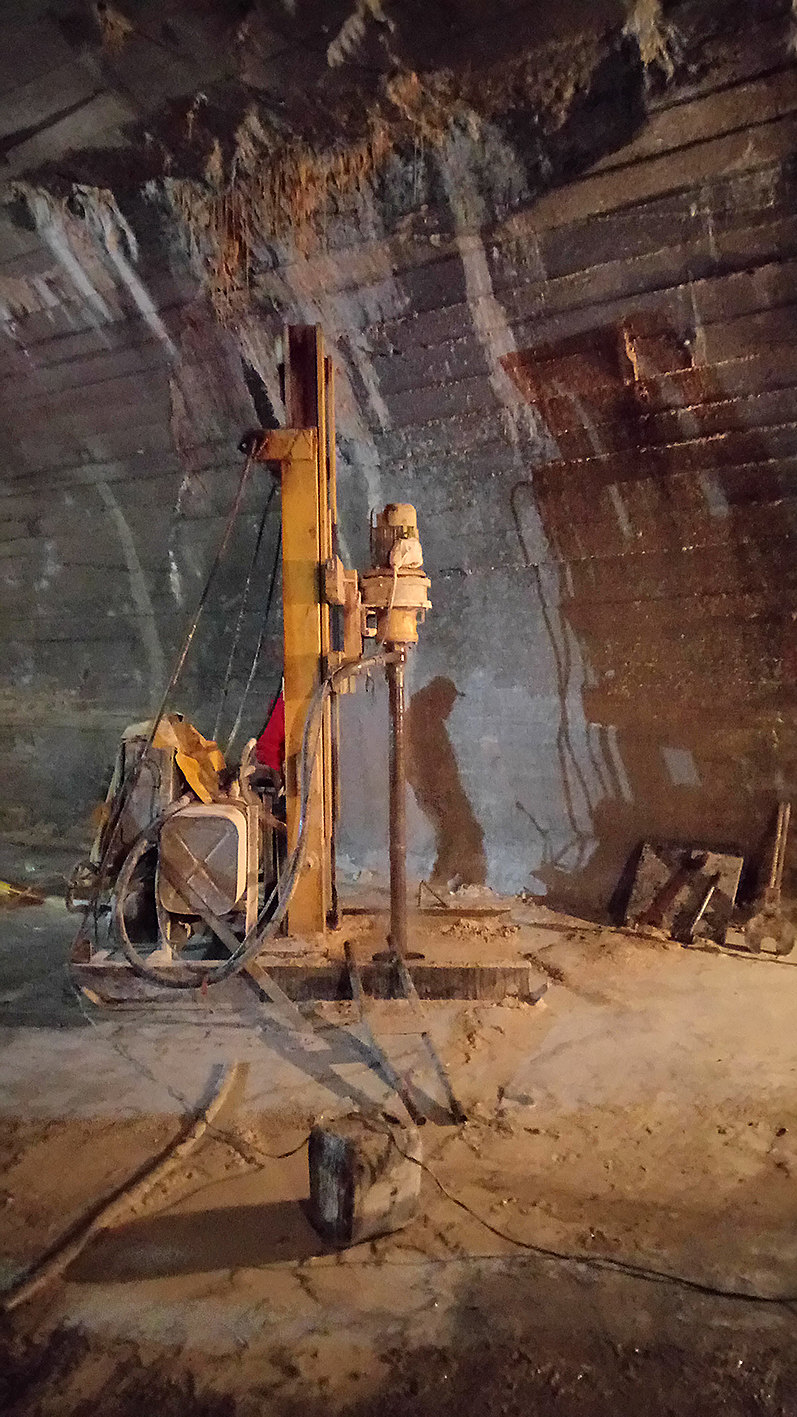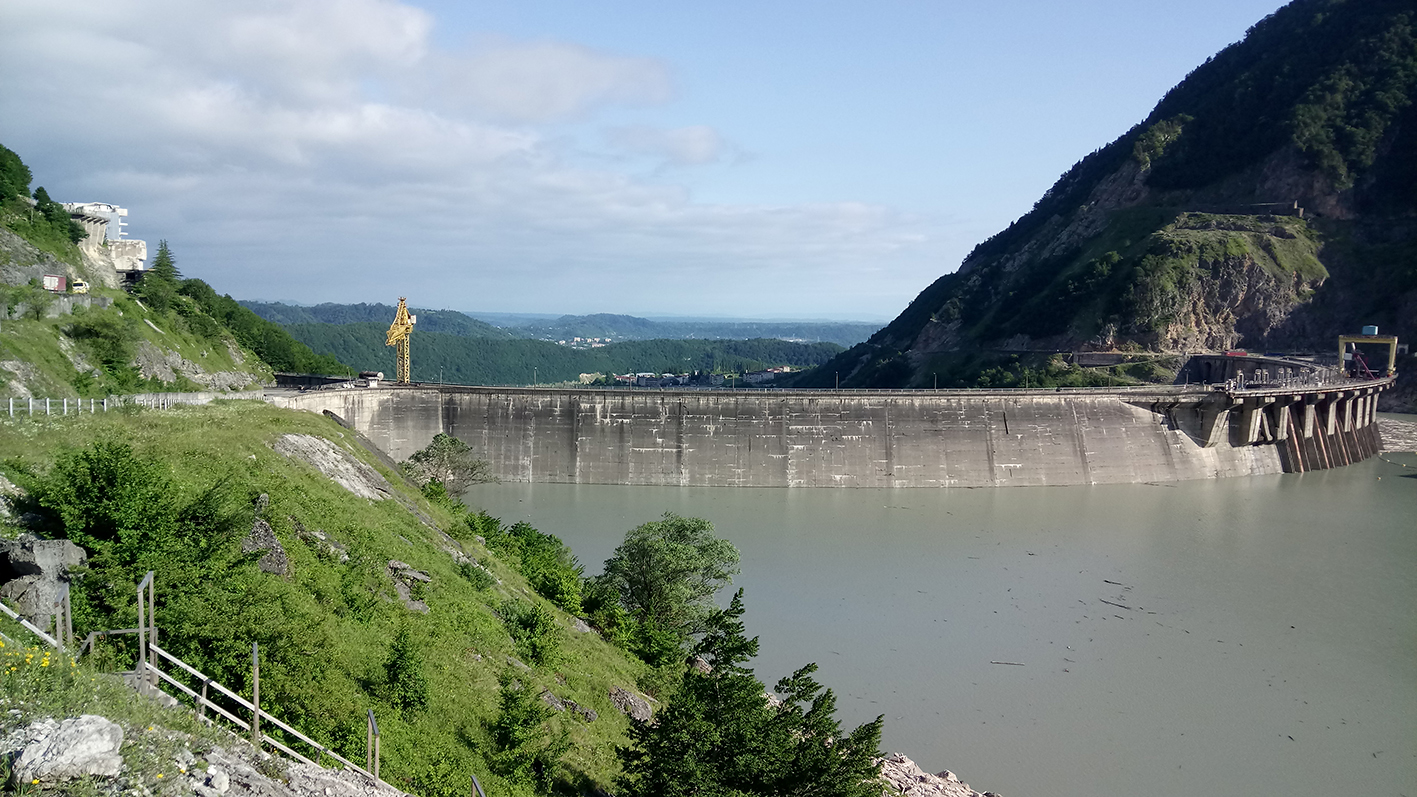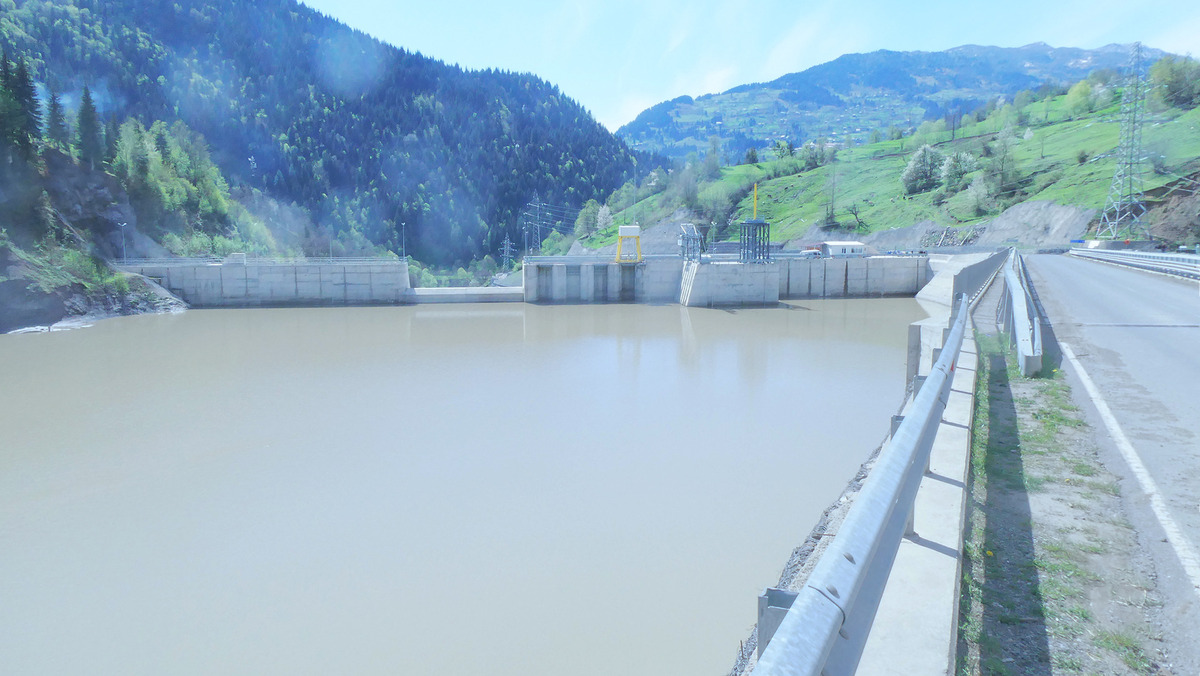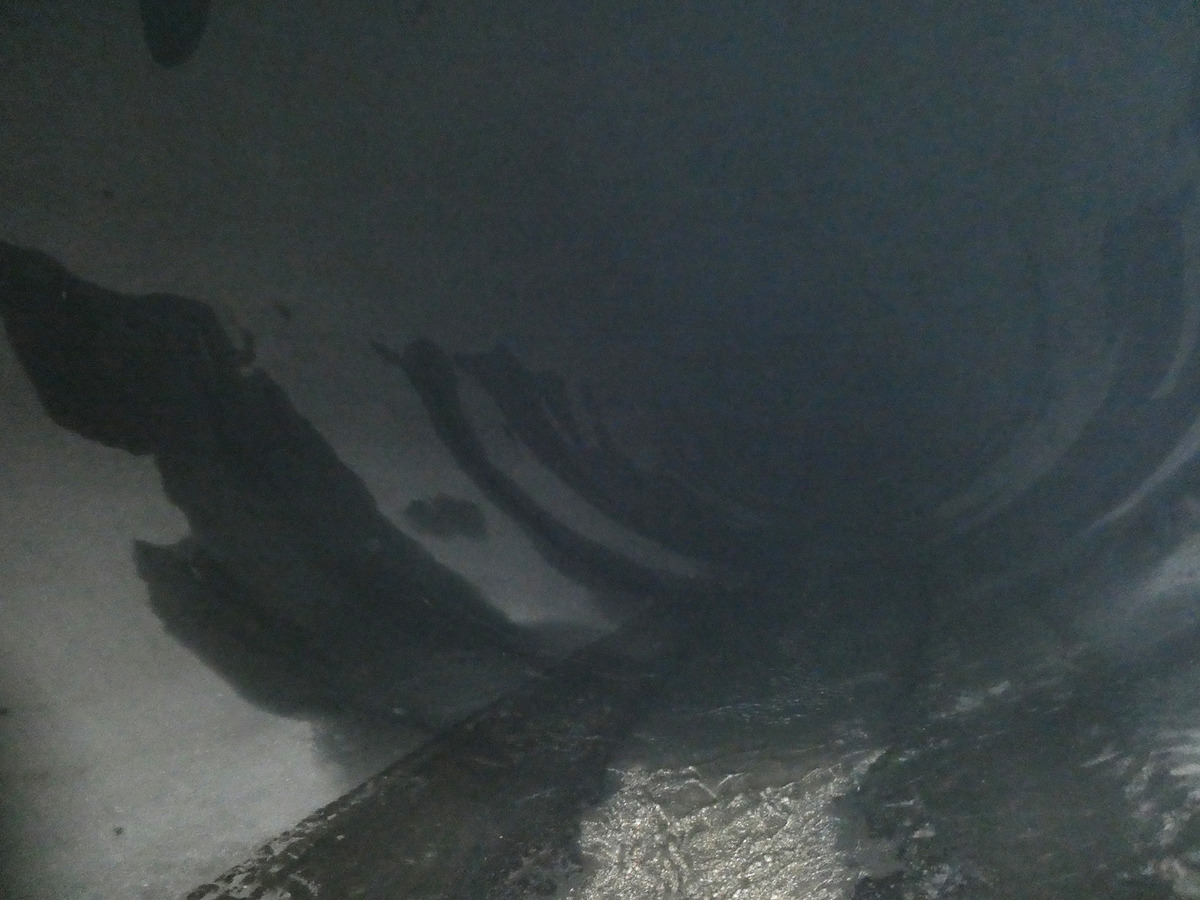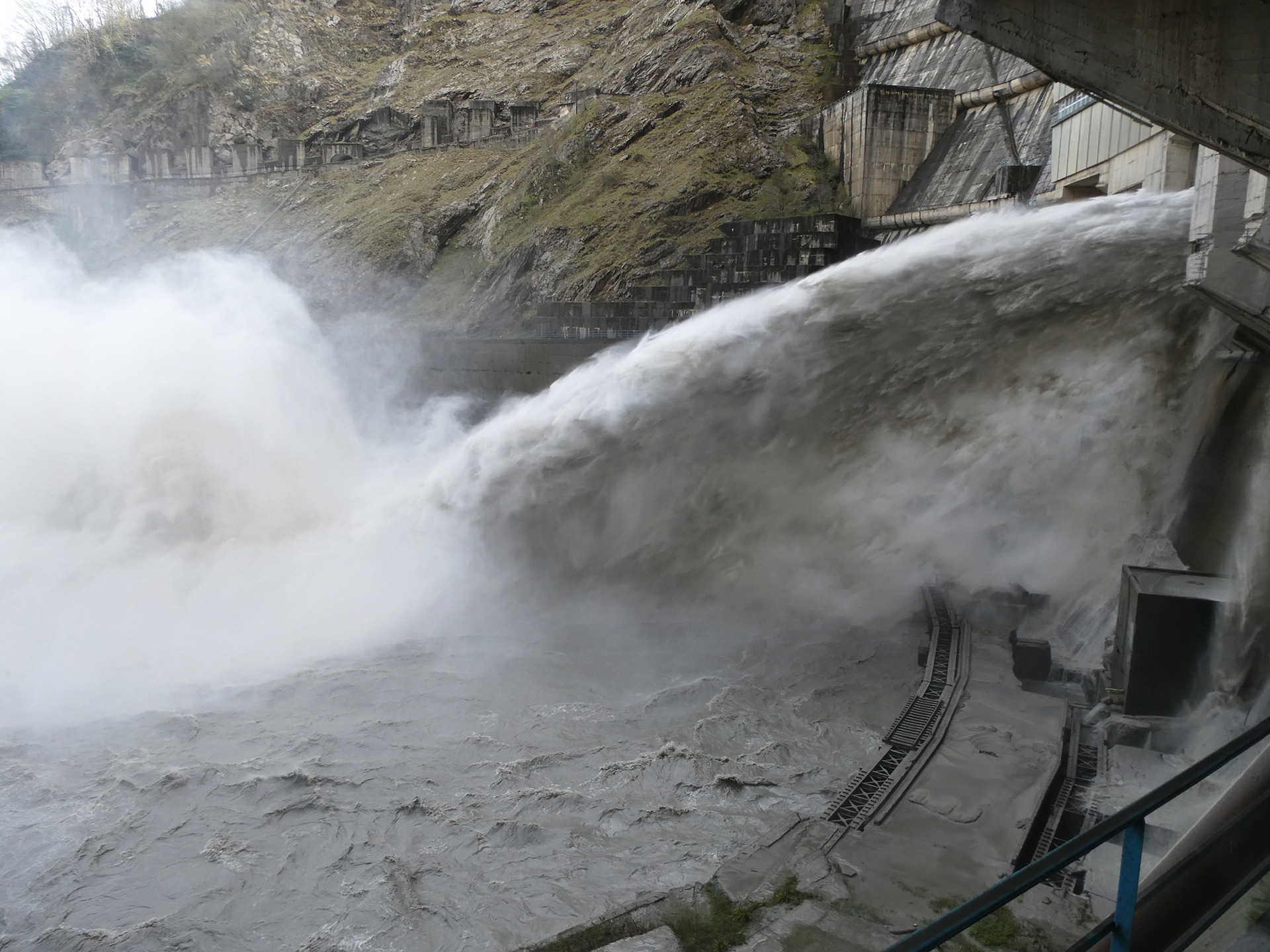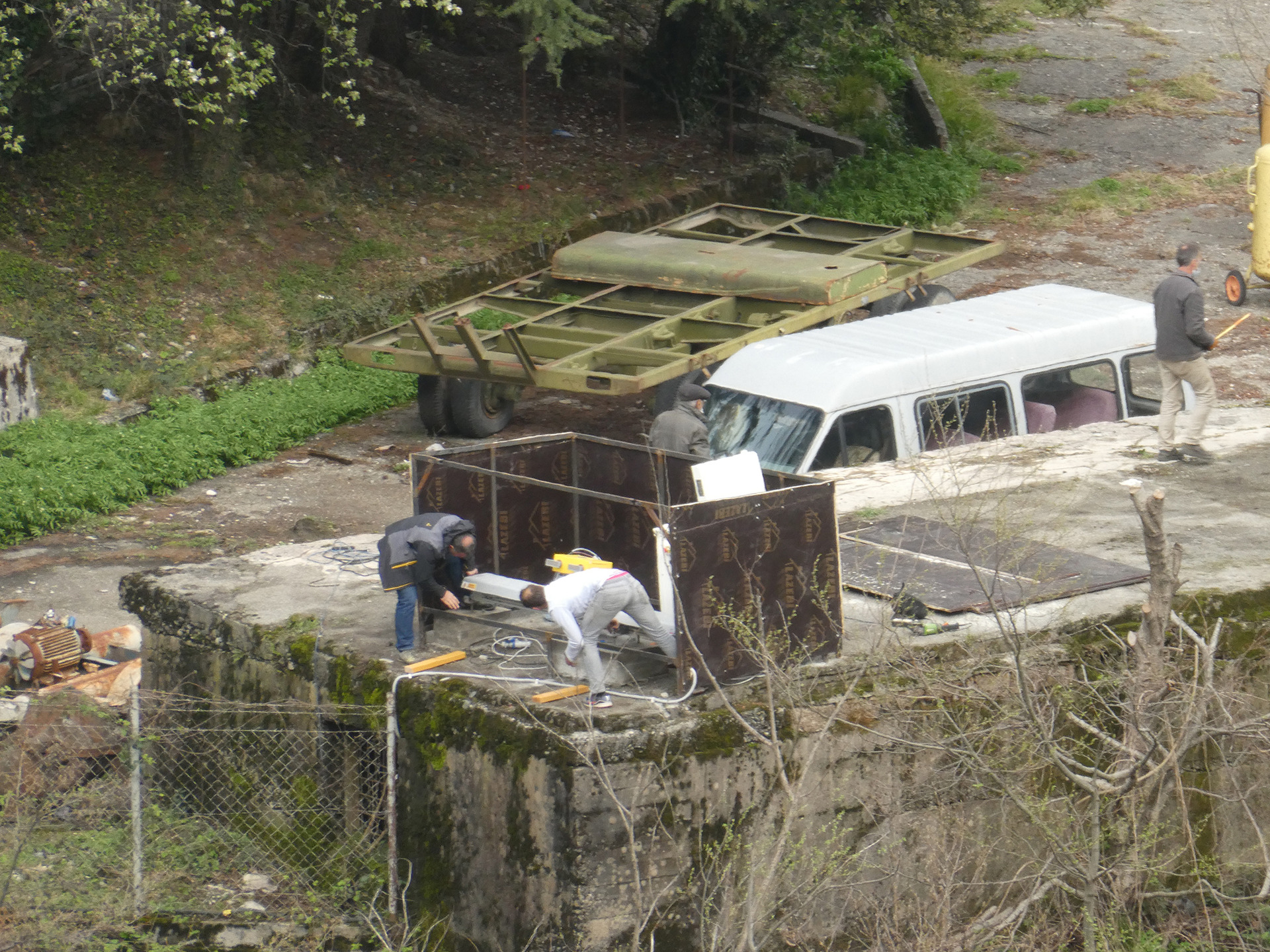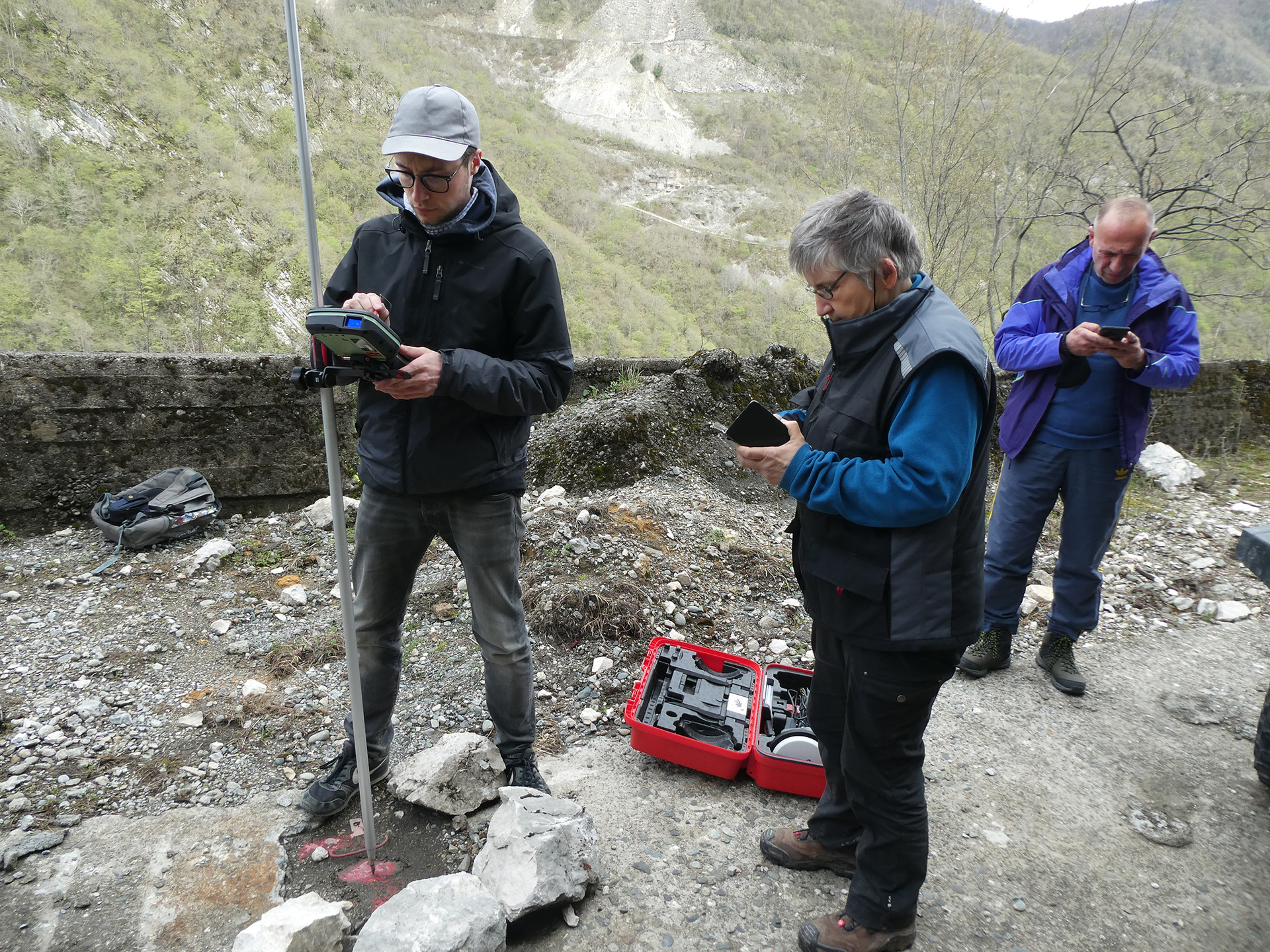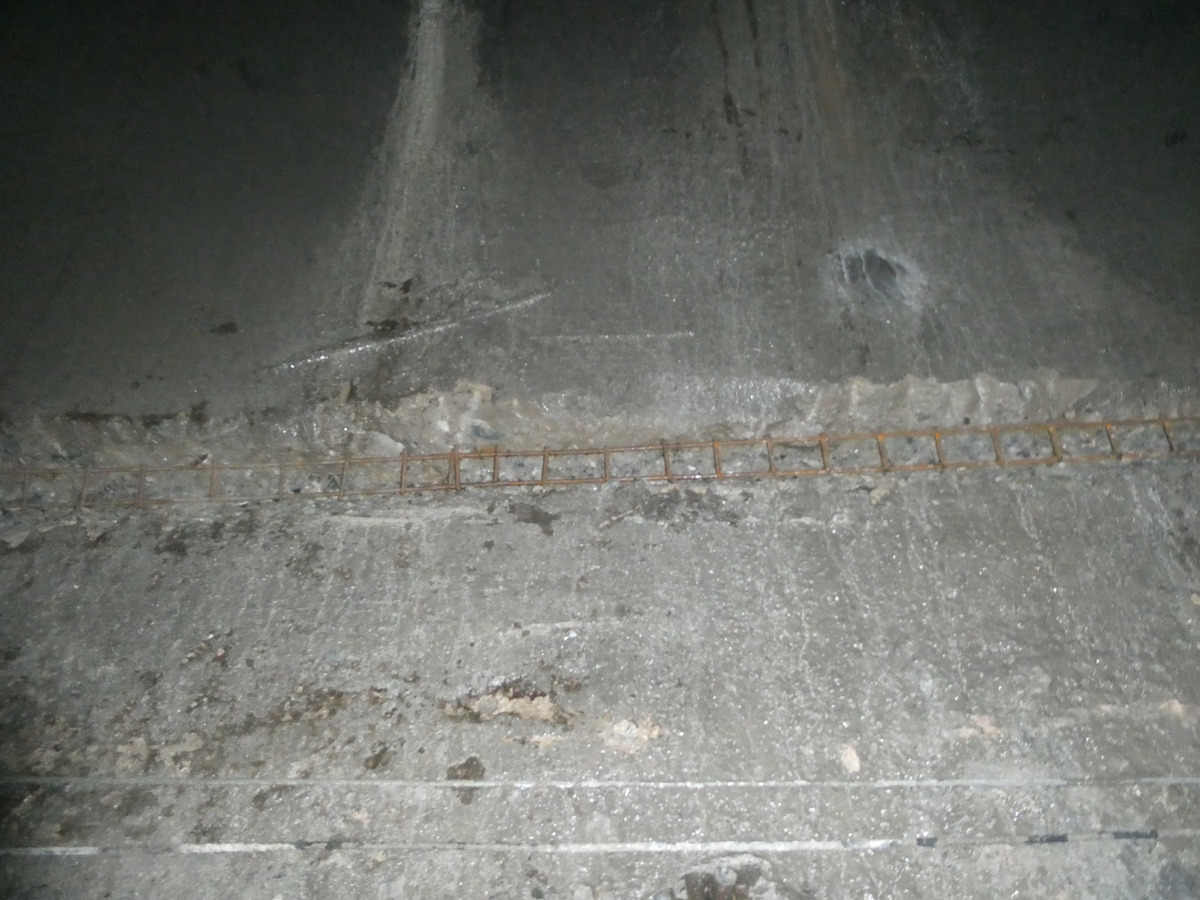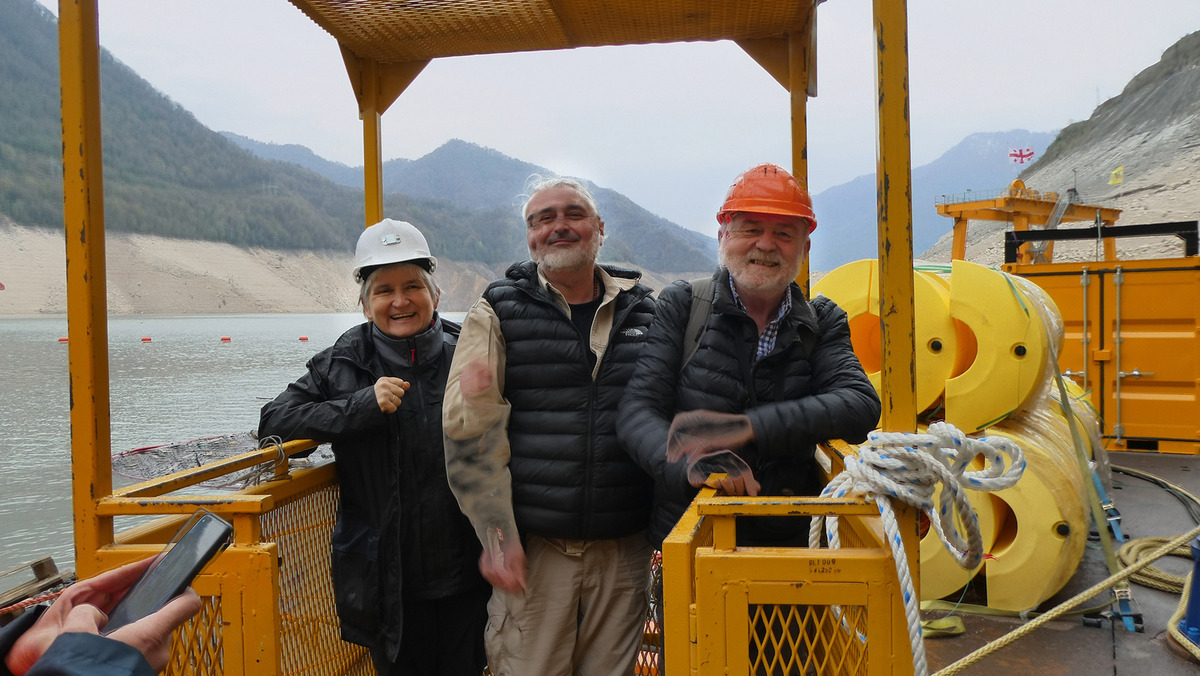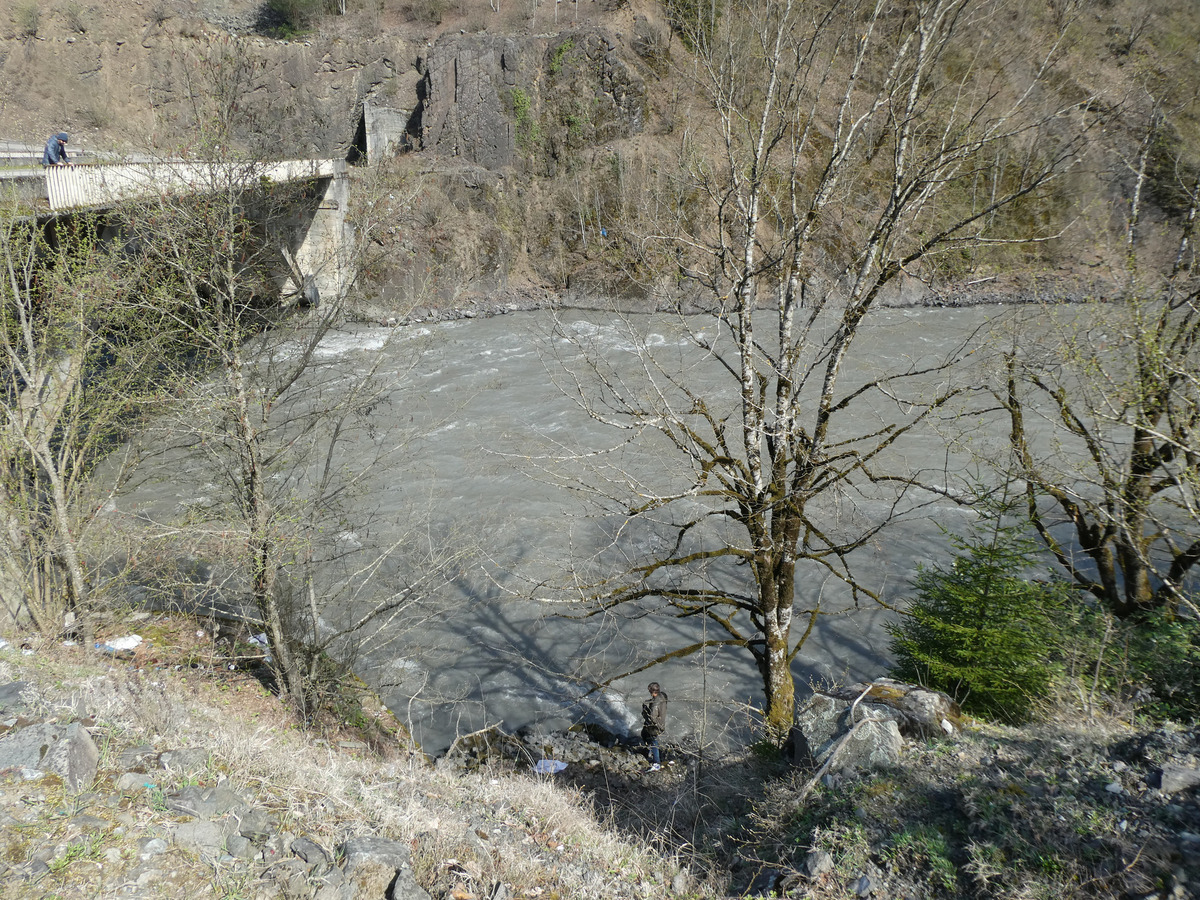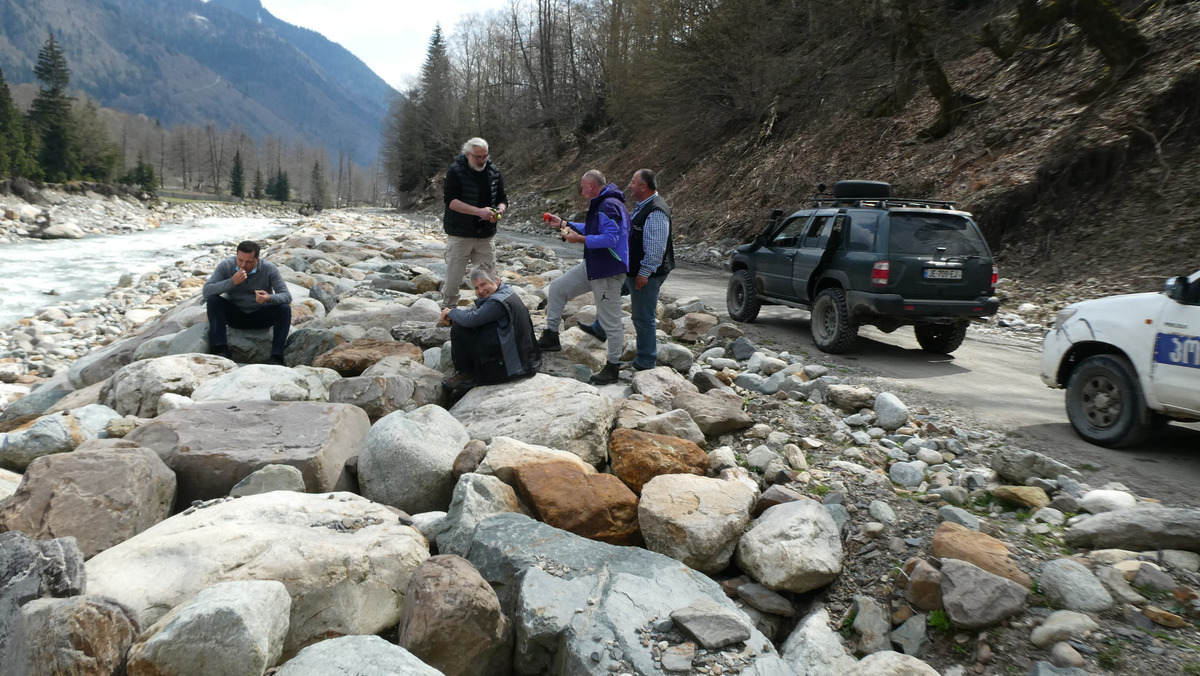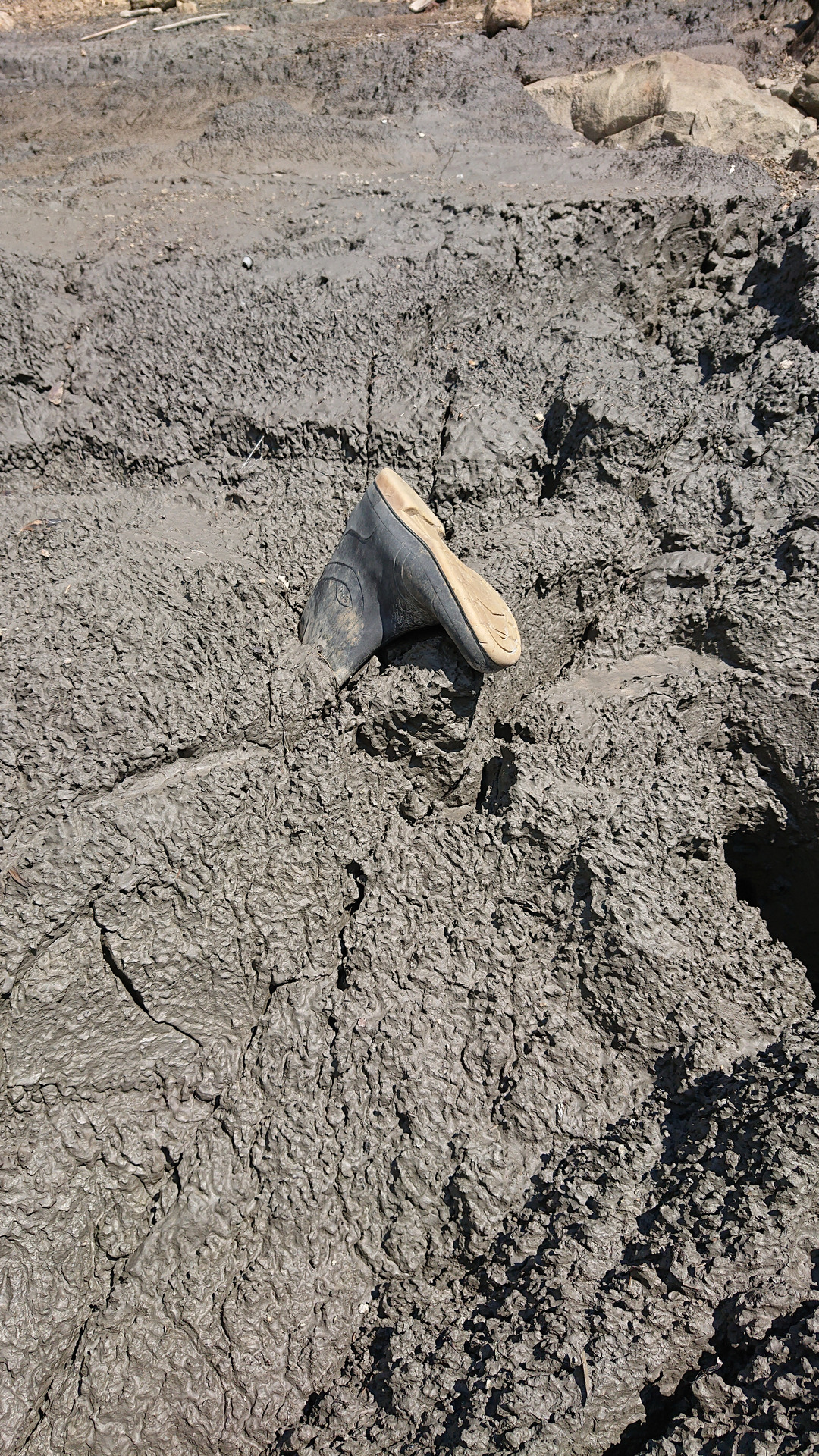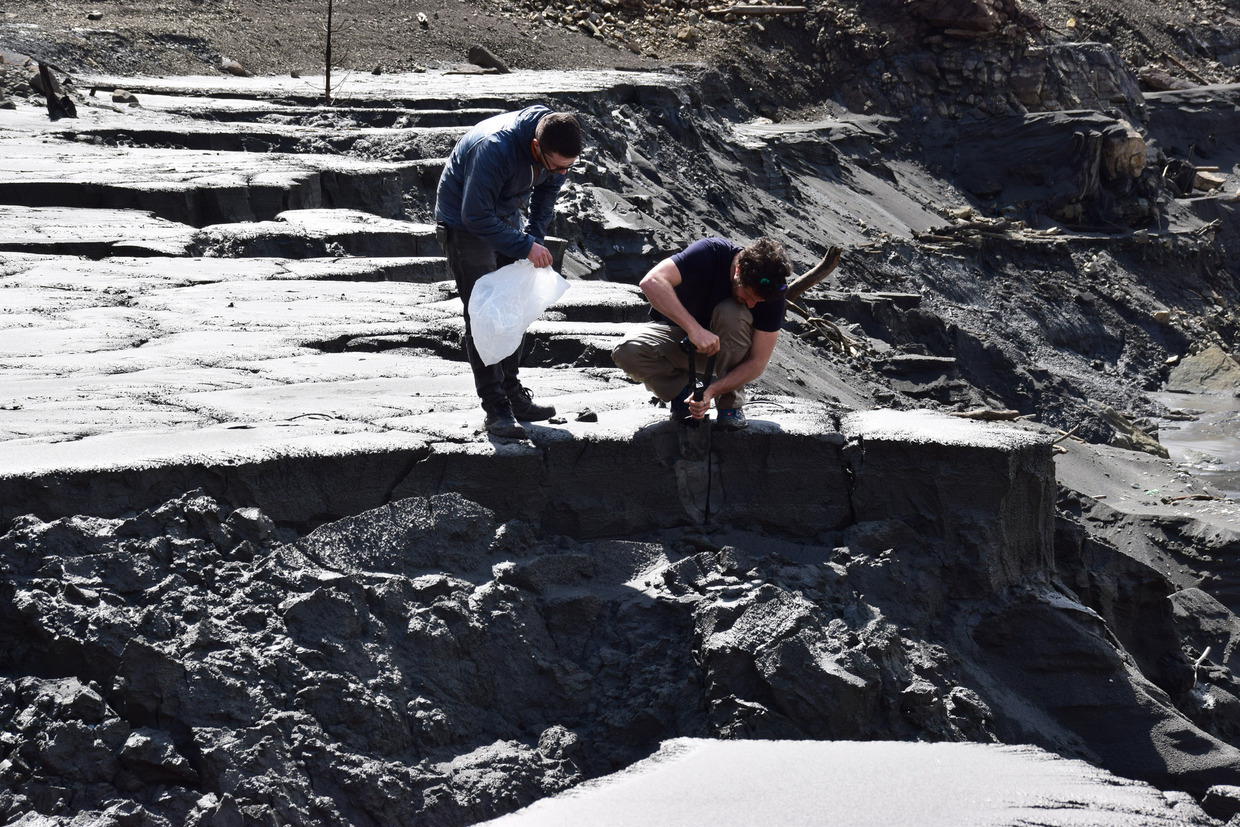Tuesday, October 5
• Complete installation and launching of geodetic measuring equipment at the permanent GNSS station “Eastside”.
• A wire mesh fence protects the solar modules against animals (Andreas Kron).
Friday, December 10
In the night at 2 p.m. we left Hotel Enguri to reach Kutaissi airport
Thursday, December 9
Final checks and works on drill cores. We have chosen those core boxes where we had numerous fractures to pick. The Nenskra cores are quite different to those of Enguri… and it is not only the color.
Wednesday, December 8
Roman helped Waldemar with the final installation works in Shtolna-1 and Thomas and Birgit went on with the drill cores of Nenskra valley drilling.
Tuesday, December 7
Early morning December 6 there was a rockfall along the road from Zugdidi to Mestia, close to one of our seismic stations. We went there today and had a look when they tried to blast the big rock. However, we could only stay to the first blast, which was only a test and did not change anything on the big rock.
In the evening we had a meeting with Director Mebonia from Engurhesi and Prof. Kalabegishvili from Georgian Technical University to discuss future plans to build a research centre and about the next steps of our co-operation.
Monday, December 6
Injection took place in the well in the Shtolna-1 by the teams of Giorgi Bochorishvili and Waldemar Wotschal from Glötzl and we watched of course the pressure development.
In the evening Prof. Kalabegishvili from Georgian Technical University joined the team.
Sunday, December 5
Giorgi organized the fittings for the injection tube… in Georgia you can organize that even on Sundays. Well done Giorgi.
Thomas and Birgit analysed drill cores of Nenskra-Well.
Saturday, December 4
Visiting Shtolna for checking injection site. In the evening Giorgi Bochorishvili and his team arrived.
Roman made first measurement with his multisensortool and Thomas Röckel and Birgit Müller analysed drill cores.
Friday, December 3
Arrival at Kutaisi airport and transfer to Potskho Etseri, after hours of customs clearance ![]()
Tuesday, October 12
Geodesist’s group leaves Potskho as the last group in the September/October 2021 field trip.
Monday, October 11
Geodetic station “Olori” is finished as the last of six GNSS permanent stations: All six stations are fully operable now.
Sunday, October 10
Exhausting day for the geodesists: Workers completely finishing their job at the abandoned station “Westside” and David and Jakob install the geodetic measuring devices and make the station fully operable, all in one day.
Saturday, October 9
Once again, the military truck is used for the geodesists: This time it transports two tons of materials to the west side of the Enguri reservoir. The journey over the stony roads in the mountains takes almost three hours.
Friday, October 8
David and Jakob performing further levelling survey, while workers are highly motivated to go on with their work at “Olori”.
Thursday, October 7
Geodesy field workers manage a logistical masterpiece in transporting nearly two tons of materials to the remote "Olori" station. A military truck was used.

Wednesday, October 6
Geodesists performing terrestrial levelling measurements at the station “Hotel”.
Monday, October 4
Geodesists performing further preparation work, mainly logistical nature.
Sunday, October 3
• Jakob and David configurate geodetic devices and doing further necessary preparation in the hotel.
• The foundation of of two strip concrete foundations and the steel framework for the solar power modules is finished (Andreas Kron).
Saturday, October 2
Geodesist’s group doing the installation of measuring devices at station “Eastside”, while workers are already doing initial construction at the next station “Olori” in the foreland of the dam.
Friday, October 1
Morning meeting with Sarah Zielonka, the Embassy's Economic Officer, at the Embassy.
In the afternoon meeting with representatives of the GTU and TSU.
Geodesists go shopping in Zugdidi, especially metal workshop.
Thursday, September 30
• Felix Bögelspacher finished his work on KIT-4.
The workers for the geodesists doing excellent construction work at the geodetic station “Eastside”.
• Together with the Georgian colleagues and construction workers, the final location of the solar system was determined (Andreas Kron).
Wednesday, September 29
• Felix Bögelspacher was able to install the seismometer in Abkhazia. Great success.
The geodesists Malte, Jakob from KIT and David from TSU go to the west side of the Enguri reservoir by boat to explore potential sites for a geodetic station.
• Back@Enguri: After the water level and discharge gauges couldn´t be delivered in time due to delivery bottleneck of electronic components, the field trip focused on the construction of the solar system for the energy supply of the enguri gauge (Andreas Kron).
Tuesday, September 28
In the evening Director Mebonia came to the hotel. After exchanging important information, we celebrated together.
Geodesists are exploring a potential site for an additional GNSS permanent station near the Engurhesi Administration Building.
Monday, September 27
Puzzling the cores. The geodesists and photogrammetry colleagues go shopping in Zugdidi.
In an evening session, workers perform initial preparations for the construction of the geodetic station on the east side of the reservoir.
Sunday, September 26
Speed-up while puzzling the cores, while Jonas and Frederic have to defend their test stand against the cows of Potskho. Jakob and Malte do preliminary reconnaissance for the construction of a new geodetic station at the old geophysical station.
Saturday, September 25
Conclusion of the Geomechanic Workshop. Arrival of the geodesists at Potskho.
Friday, September 24
Dismantling of the Solexperts equipment and return journey of the colleagues.
Thursday, September 23
Return of the Solexperts team to the Enguri Valley and testing of the KIT-4 well. Afterwards the well was surveyed with the televiewer.

Example of Core Scan of drillcore from borehole KIT – scanned by Carlos from DMT together with GTU and KIT PhD-students.
Wednesday, September 22
Completion of the impression packer work in the Nenskra valley. Packers were successfully set. In the Enguri Valley we could log of the KIT-4 well with the acoustic and the optical televiewer. Great data.
During all the week the PhD students have been scanning drill cores in hotel Enguri together with Carlos Garci Pina from DMT company and made very good progress. It seems also that the team has a lot of fun doing that.
Tuesday, September 21
At 11 am the last hydraulic testings were finished and the equipment was removed. At 11:30 the televiewer measurements could start. In the field, new fracs were hardly visible on the televiewer images. Therefore it was decided to place impression packers at least in 4 depths. This work started in the afternoon. The logging crew returned to Enguri, where in the meantime, Prof. Kalabegishvili arrived with the students Tamar and Georgi.
The seismology team set up the Gulb station in the mountains. Seismologist Emmanuel drove past the hotel in the Russian heavy goods vehicle and waved like the Queen of England (we have no photo… what a pity). In the evening came the confirmation that the next day the DAS cable will be installed.
Monday, September 20
Fracking in the Nenskra drillhole after having managed to build a transition piece from the generator to the testing equipment. Until the evening 6 fracks or reopenings could be done. The drill rig mobilized to Enguri Valley and could remove the blue tube string from KIT-4 borehole.
Sunday, September 19
The team moved towards Nenskra Valley in the morning and in parallel the drillers removed the drill string. In the afternoon we started televiewer logging in the Nenskra borehole. However, our Televiewer is quite a light tool and the centralizers made entry almost impossible. Thanks to Eduard Scheck's modification to reduce the centralizer diameter then worked out and we got super data, logging worked well both going down and up in the borehole.
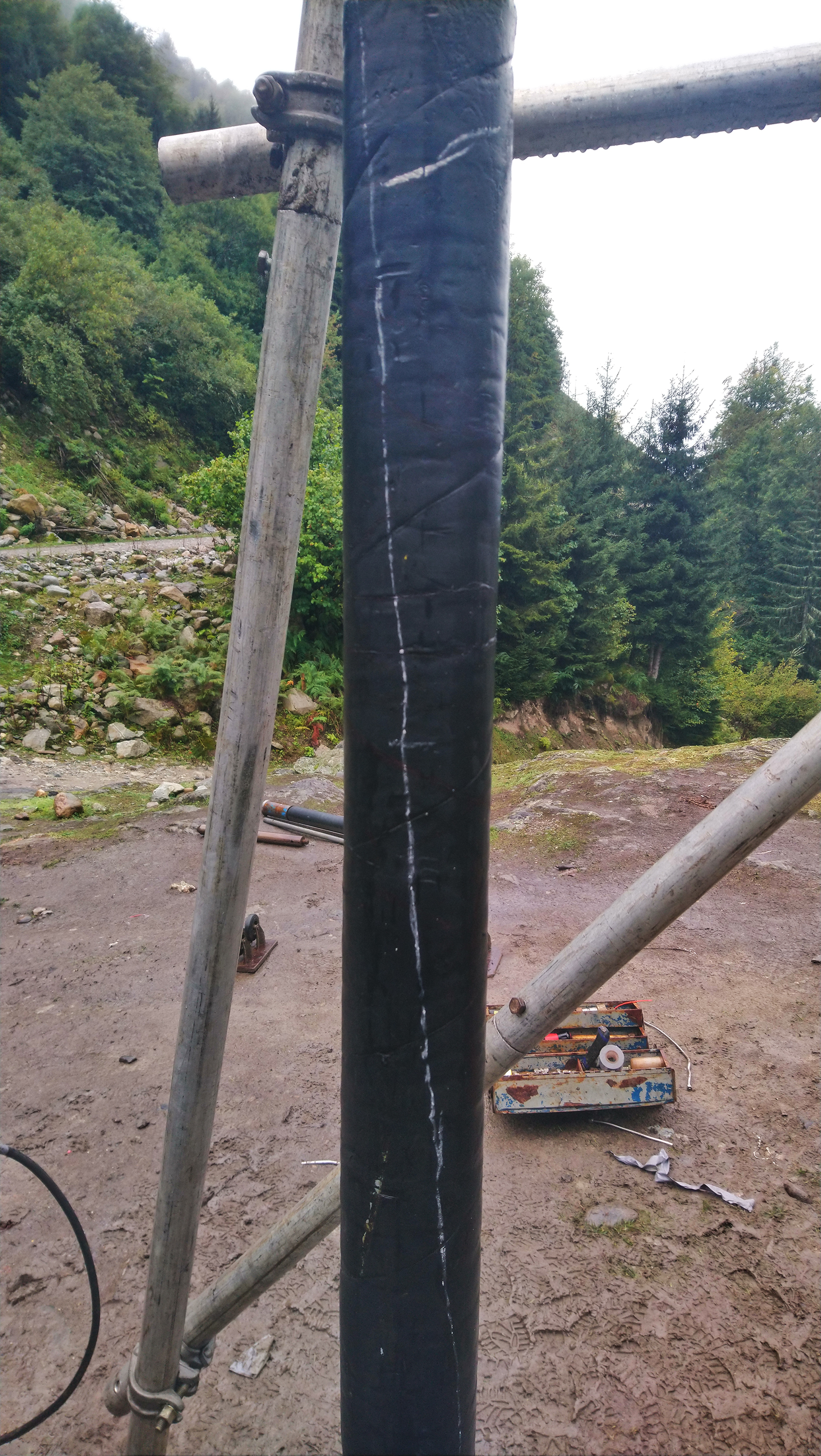
Vertical fracture outlined on impression packer. The hydraulic testing is used to determine the minimum horizontal stress magnitude.
Saturday, September 18
The pump worked well and we were supposed to start, but big shock, the packers were stuck at 18 m depth. Hours of trying unfortunately resulted in no progress and we had to abandon the HF in KIT-2 and develop a new plan to get magnitude data from hydraulic testing in the Enguri Valley. In the meantime the drillers finished the Nenskra drillhole. During the night, the drill string was left in the borehole for stabilisation.
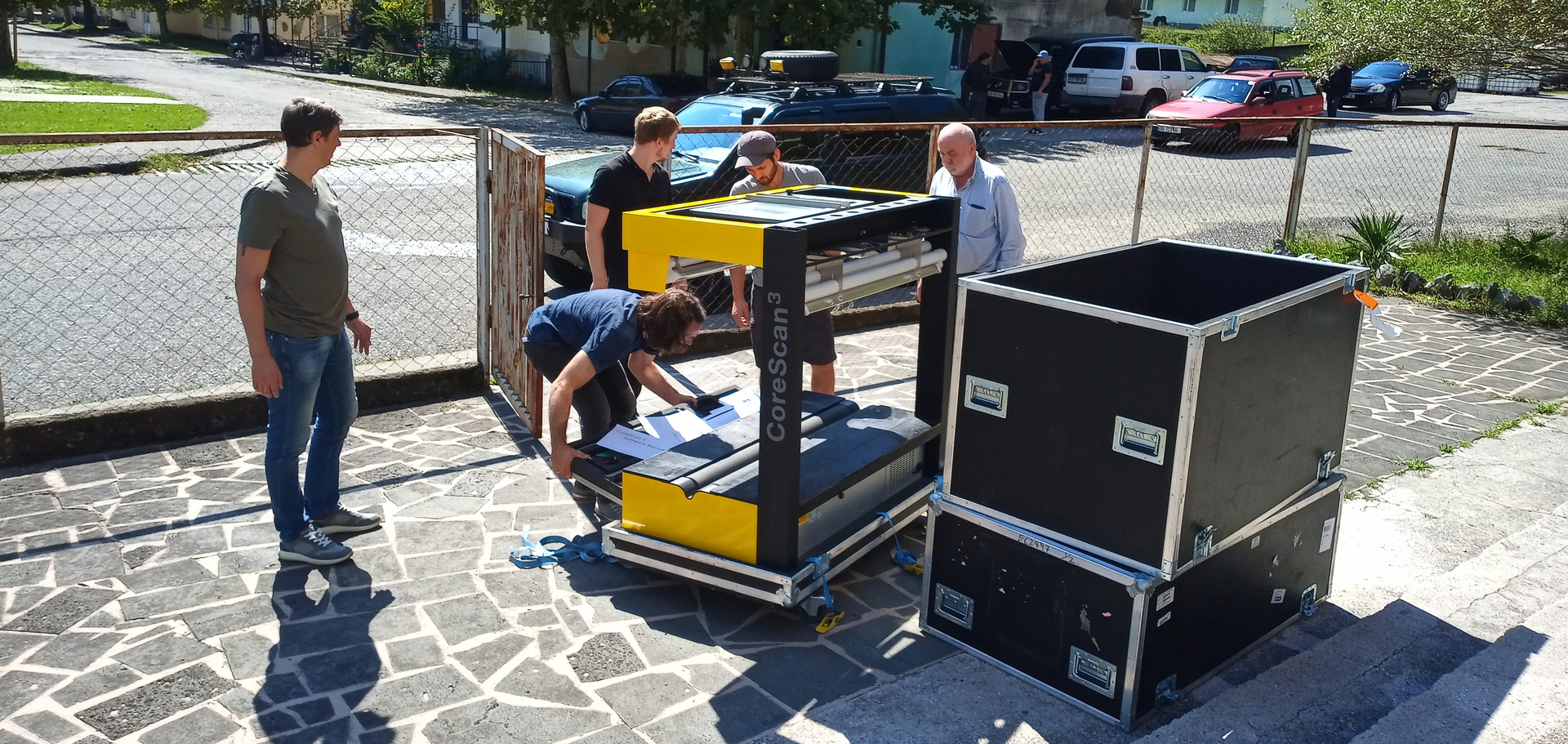 Arrival of DMT core scanner
Arrival of DMT core scanner
Friday, September 17
Finally we have electricity and at 9:30 am we unloaded testing equipment at KIT-2. In the pouring rain, everyone struggled to set up. Measurements were supposed to take place at 4 pm. However, the first measurement interval proved to be too permeable, so only a StepRateTest was started... until the pump failed. The colleagues from Mesy then dismantled the packers until 7 pm and the rest of the team scoured the hardware store in Zugdidi to find a new pump and especially connectors. The latter proved to be a real challenge.
Thursday, September 16
At 12 o'clock the relieving news: the truck has passed customs and it actually arrived around 5 o'clock. The electricians from Engurhesi started to lay the cables to the drilling site because the generator is not there yet.
Wednesday, September 15
Custom procedure is still ongoing, now they want descriptions in Georgian language. Nino and Emmanuel have translated at night. In the morning meeting with Director Chania to discuss the DAS cable infrastructure. Afterwards we checked the material in the warehouse.
Tuesday, September 14
The Custom procedure is horrible. We have sent money to the poor truck driver sitting in Batumi. Meeting with our Seismologists who arrived at the dam.
Monday, September 13
We tried to pull out the plastic tubing from KIT-4 to log it with the televiewer. This was impossible. We would need the drill rig for it. Alternatively, we have logged the KIT-2 with the new optical televiewer down to 304 m. Now we can have a direct comparison from cores, optical and acoustical televiewer. In the meantime, drilling at Nenskra has reached 232 m.
Comparison of optical and Comparison of optical and acoustical televiewer data from logging in the borehole KIT-2.televiewer data from logging in the borehole KIT-2.
Sunday, September 12
Successful testing of the logging equipment (it was transported across very rough roads, thus testing was necessary). Truck still in Batumi customs.
Saturday, September 11
Video conference with SU Irma Grdzelidze, Irina Gamkrelidze, Irakli Samkharadze, Murman Margvelashvili, Nino Okribelashvili (Vice Rector), Stefan Hinz (KIT-IPF). The drill string got stuck, thus there was not a real progress in depth. Eduard Scheck from BLM arrived.
Friday, September 10
The equipment of Mesy reached Georgia and got stuck at customs. Now we do not only have lots of cores but even more mails with customs and brokers and shipping company. The drillhole at Nenskra reached 212 m.
Thursday, September 9
Lots of cores are analysed. Meanwhile Thomas Röckel, Thomas Niederhuber, Jonas Greve, Frederic Pistor and Birgit Müller do structural core analysis. The drilling in Nenskra-Valley has reached 200 m.
Wednesday, September 8
Visit to the new core storage and discussion about its organisation, video conference with the TSU representatives.
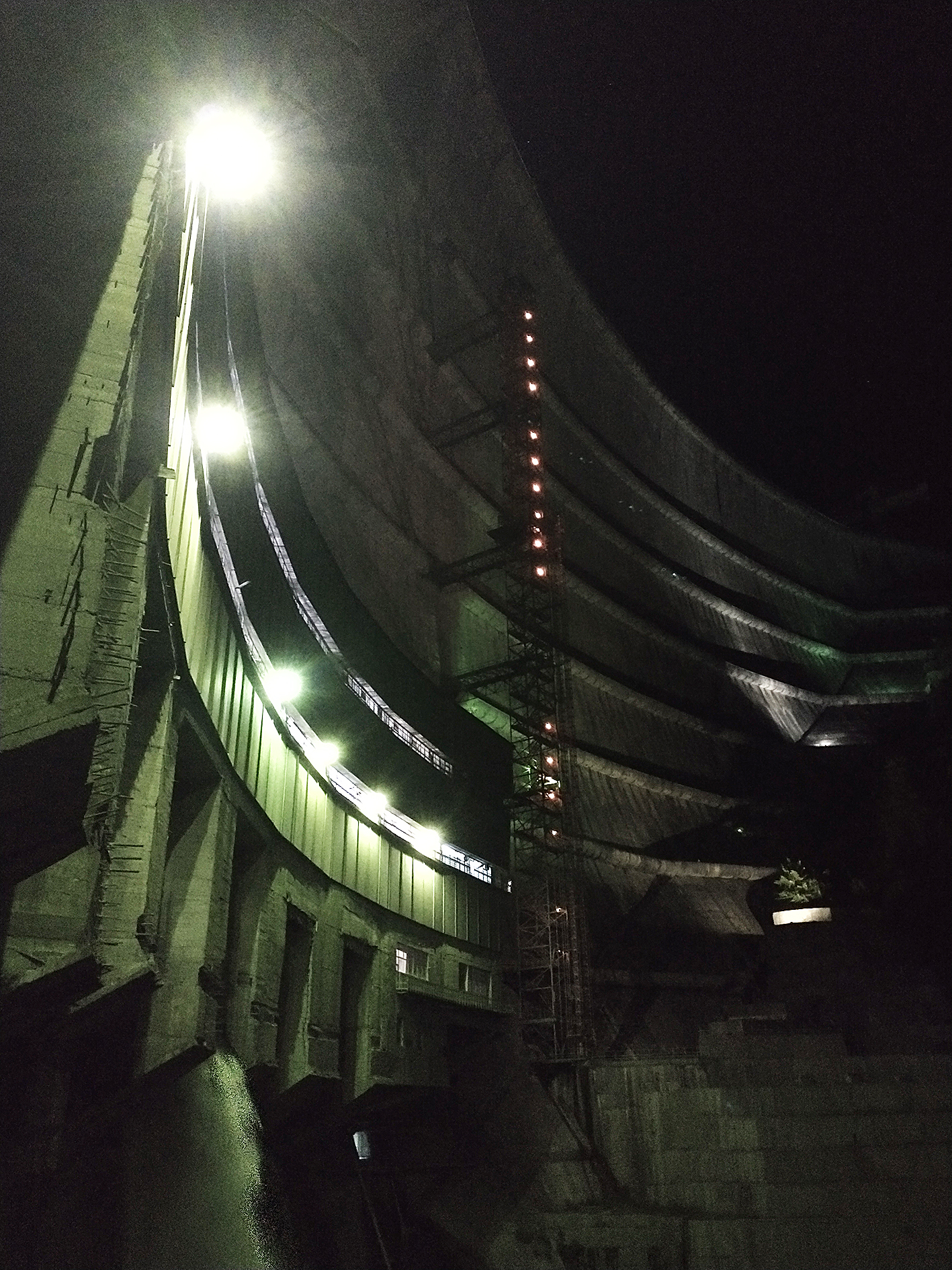
Night view of Enguri Dam
Tuesday, September 7
Core work is ongoing. Meeting with Director Chania and Director of Board Mebonia. Discussion about the archiving of the cores, the location of a GNSS station and monitoring of works on the Surge shaft.
Monday, September 6
Lots of core pieces have to be put together.
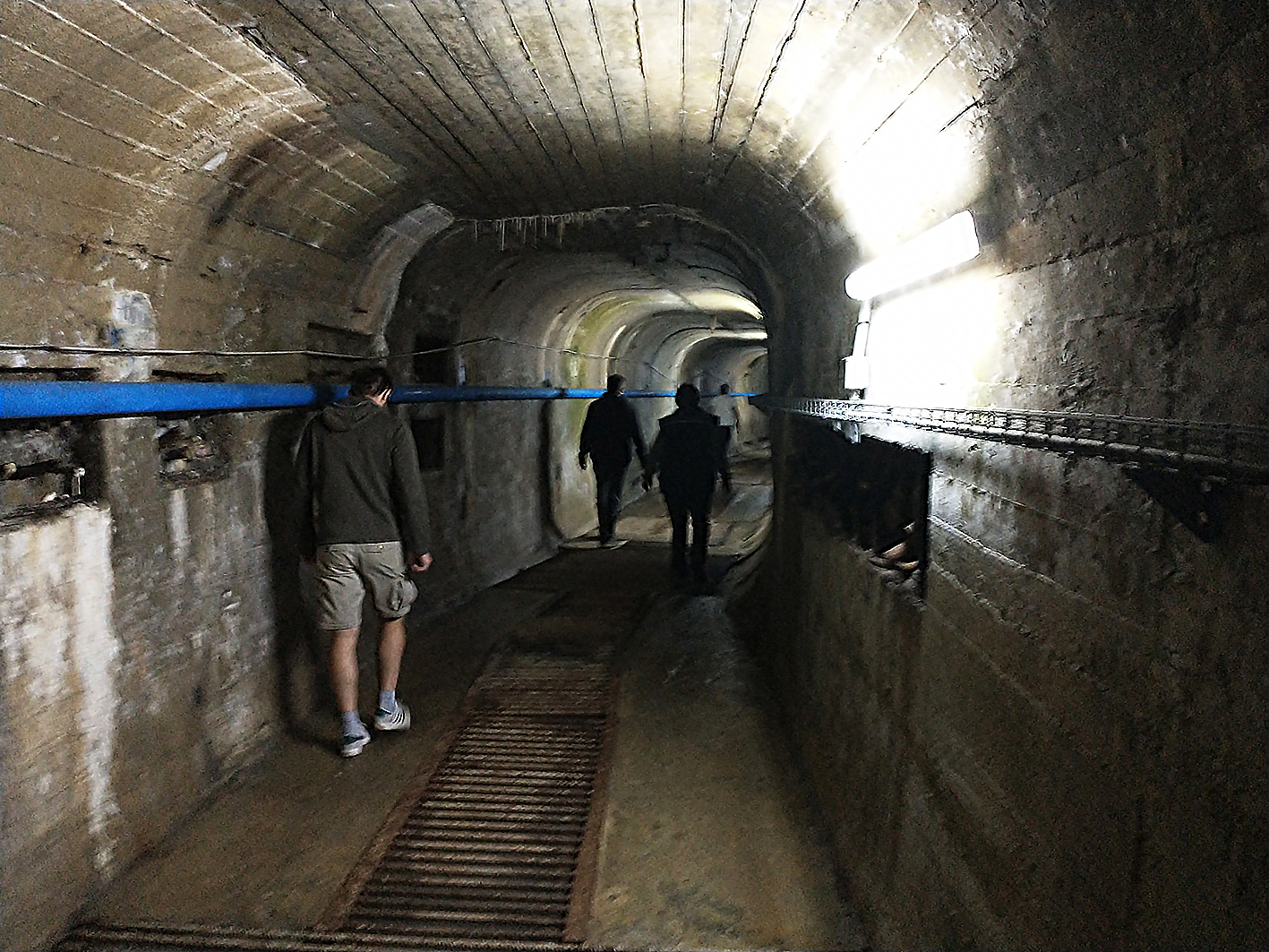
Walk through the Enguri Dam in the night
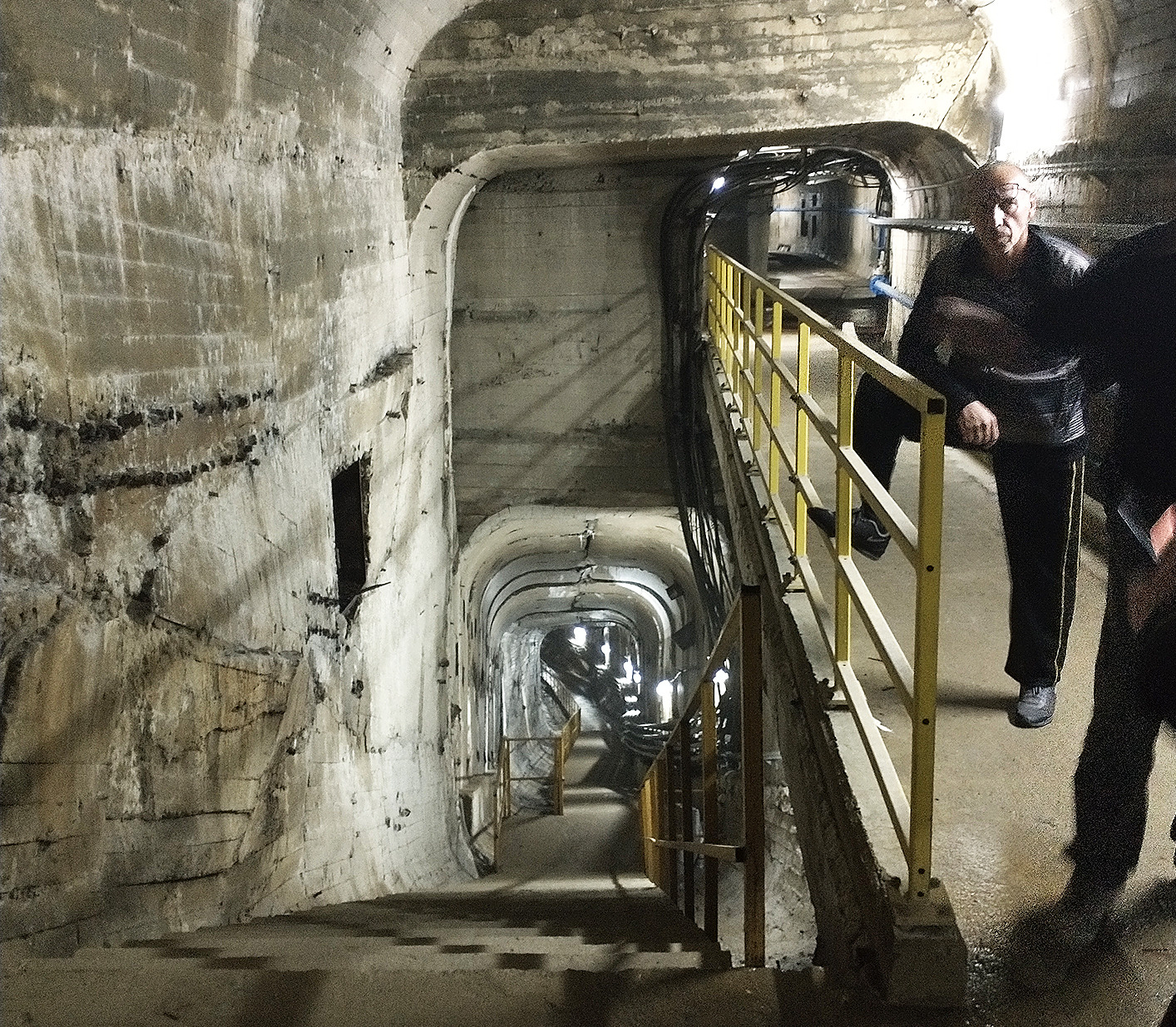
Staircases within Enguri Dam lead from the bottom to the top (271m)
Sunday, September 5
We tried to cross the mountain to the next valley to investigate Ingirishi Fault. The road condition was too bad, so we did not reach it. Instead we have investigated fault surfaces on the uppermost Enguri level.
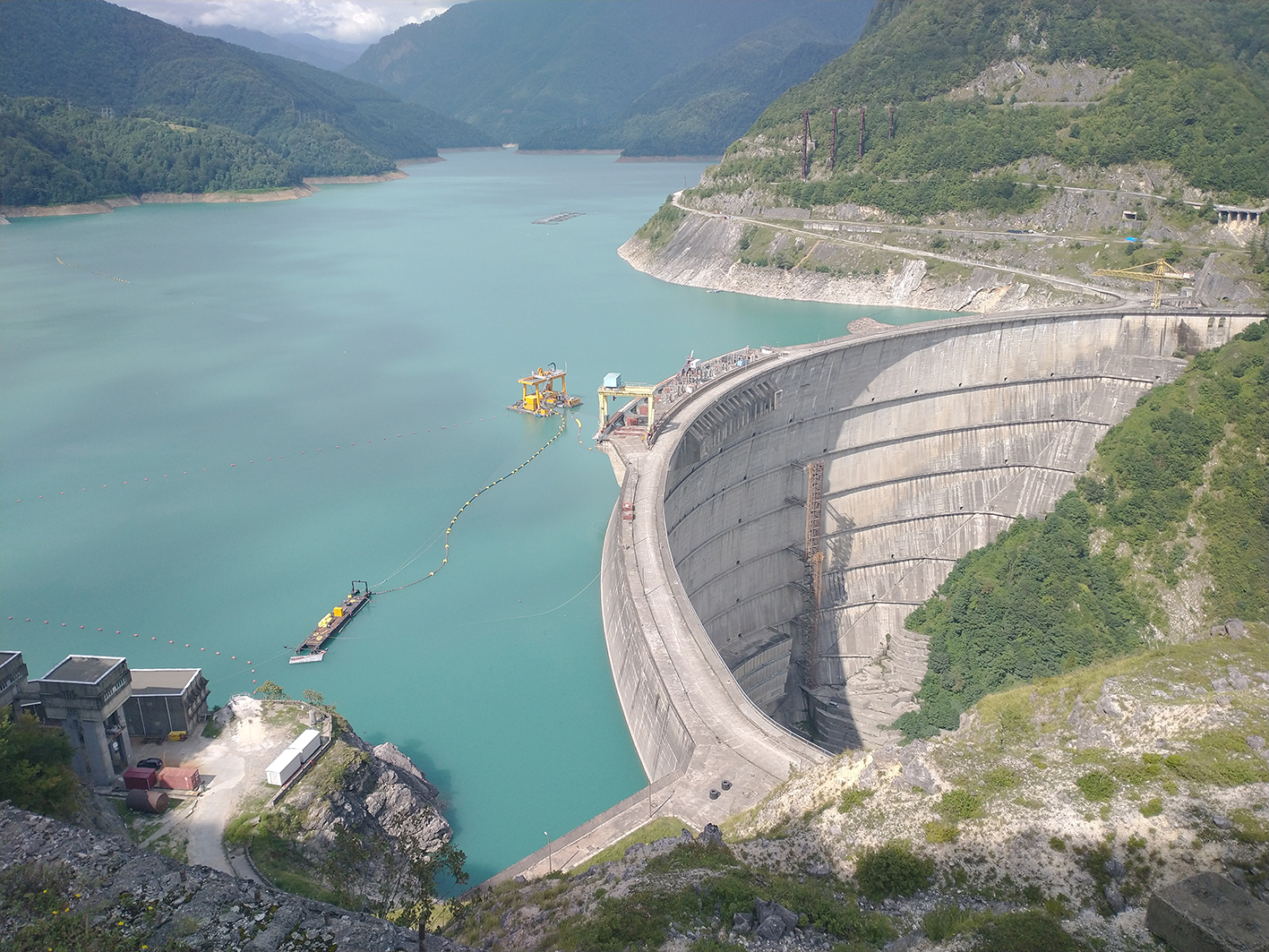
View from uppermost road level across Jvari reservoir and Enguri Dam.
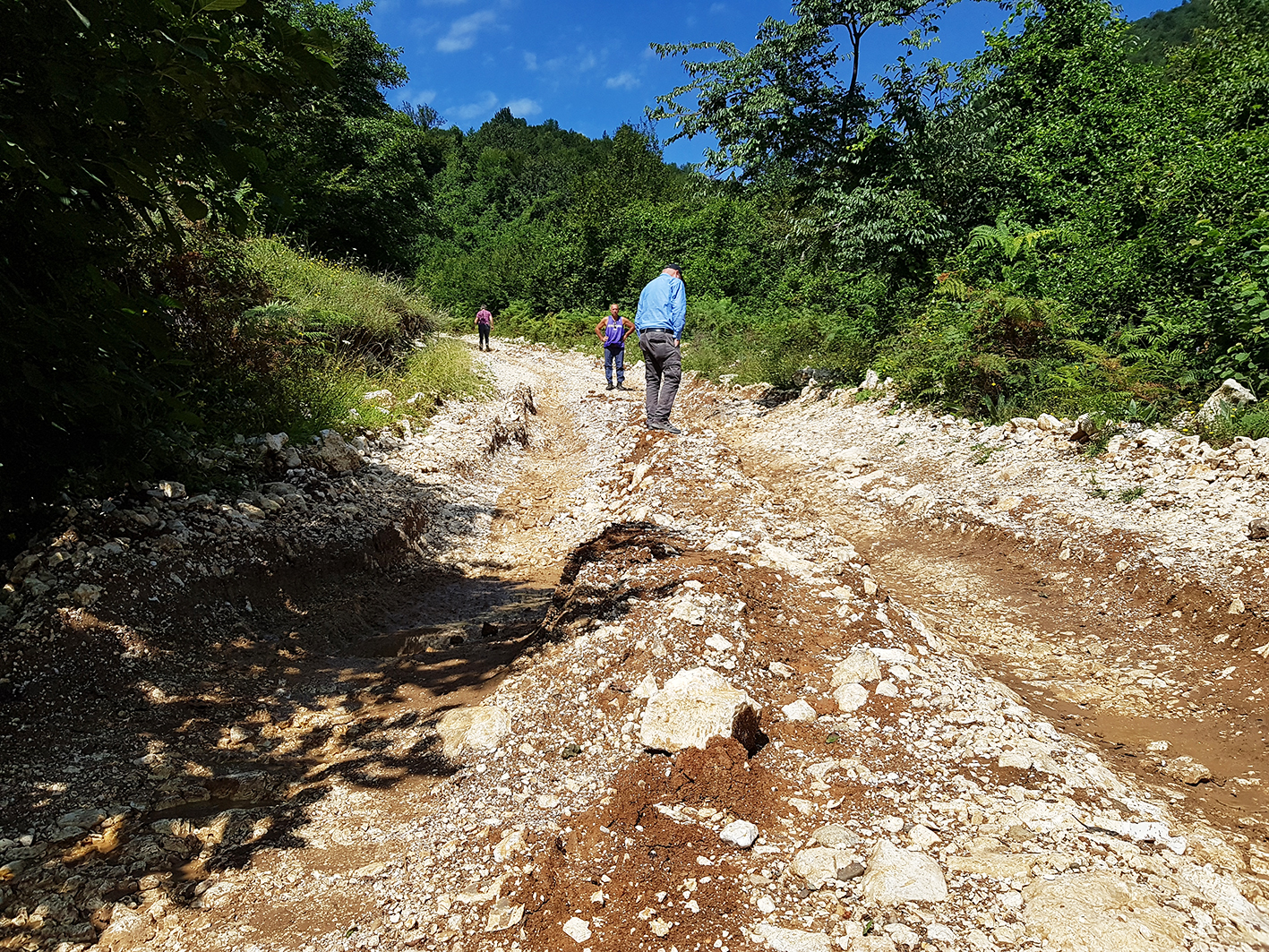
We could not cross the mountains because the road conditions had been too bad for our 4wheel drives. For these roads other vehicles are required.
Saturday, September 4
Visit to drillsite in Nenskra-Valley. The drillhole depth is 129 m. However, one important part was broken. But our colleagues in Georgia found a good craftsman who could repair it.
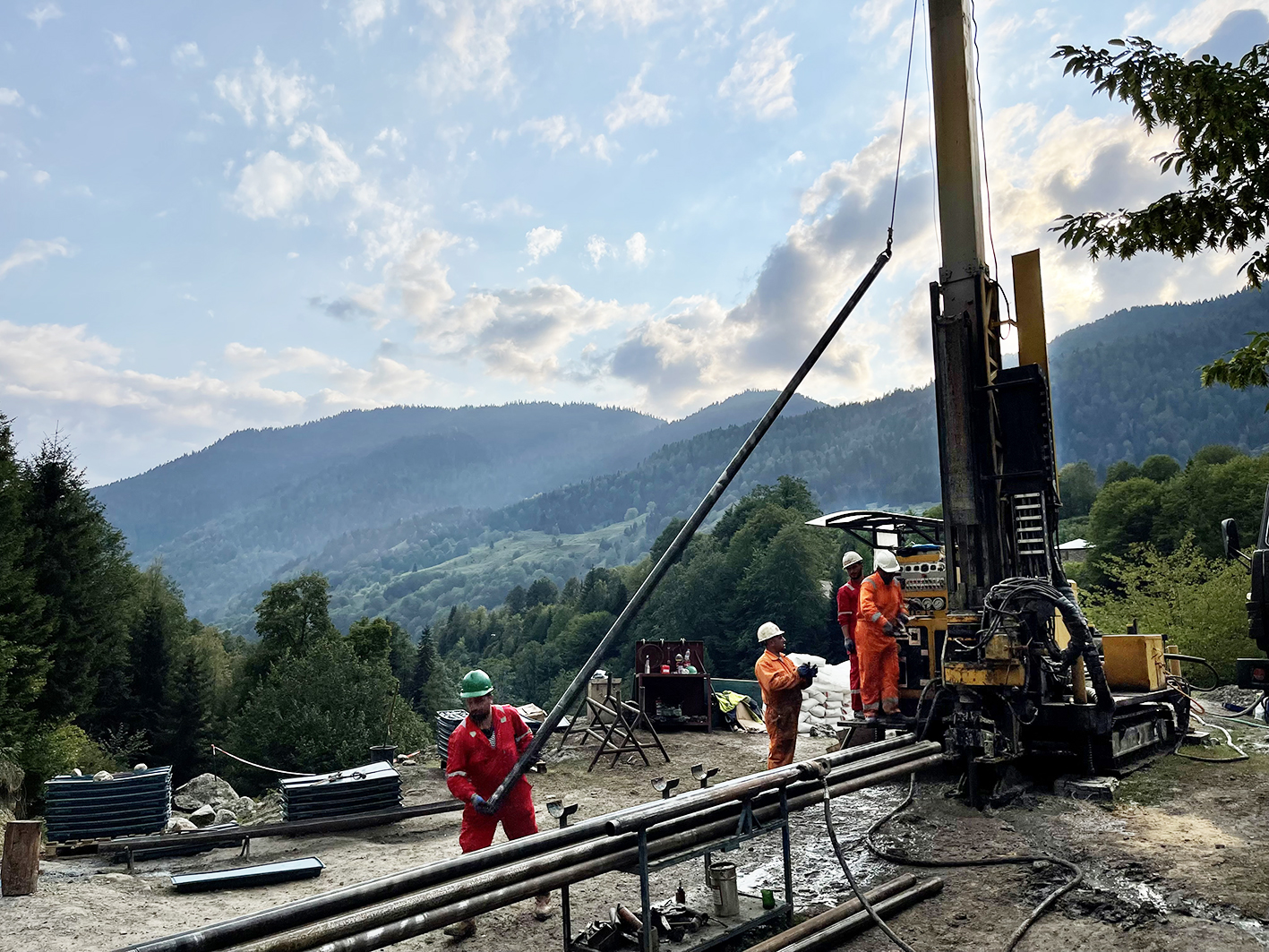
Drillsite in the Nenskra-Valley. The drillers just have extracted a part of the drill string. On the left there are 2 piles of core boxes. Here we are drilling mud rocks. At Enguri we had been drilling limestone.
Since August 20
Thomas Röckel and Luisa Röckel have been analysing drill cores of borehole KIT-2. Until September they could finish 17 core runs of borehole KIT-2.
Friday, June 25
Discussion of new drilling location in Nenskra Valley with local people. The place we have chosen is on a mudrock close to the Nenskra river. In the upper Nenskra valley first drone flights by Marinus from Bavarian air took place to get a better impression for the flight route in October
Thursday, June 24
The rest of the cementation with standard Heidelberg cement took place. Now we have to wait until the cement is hard to see whether the cementation was successful.
Wednesday, June 23
The pump from Abchasia arrived, we were really glad. But – some mechanical part of this pump did not work. Thus we changed to original plan A and filled the well through the blue plastic tube with the help of the drillers. This day we cemented until 21 o´clock with our Pagel cement. The GB-SAR is working great – even at night.
Tuesday, June 22
The first pumping mixture failed because the pump did not work. How disappointing. And this also meant that part of our special cement was spoiled. Engurhesi helped to search for another pump. In the meantime we had meetings with Joni Chania and could clarify that our young colleagues could install corner reflectors on many places at the dam construction. The ground based SAR has been installed on the right side of Enguri River.
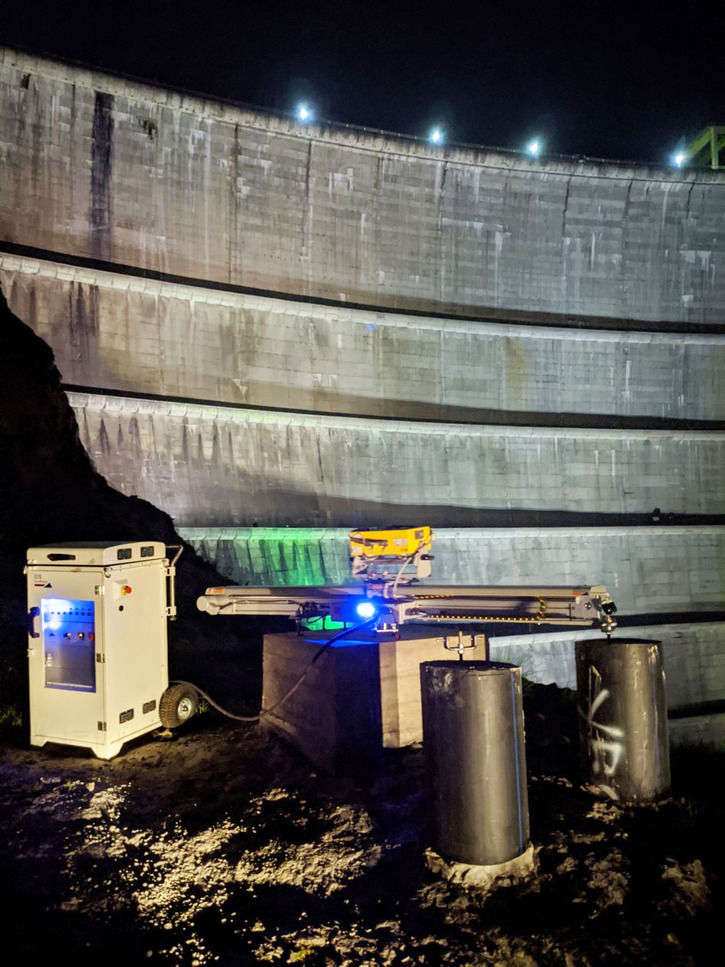 |
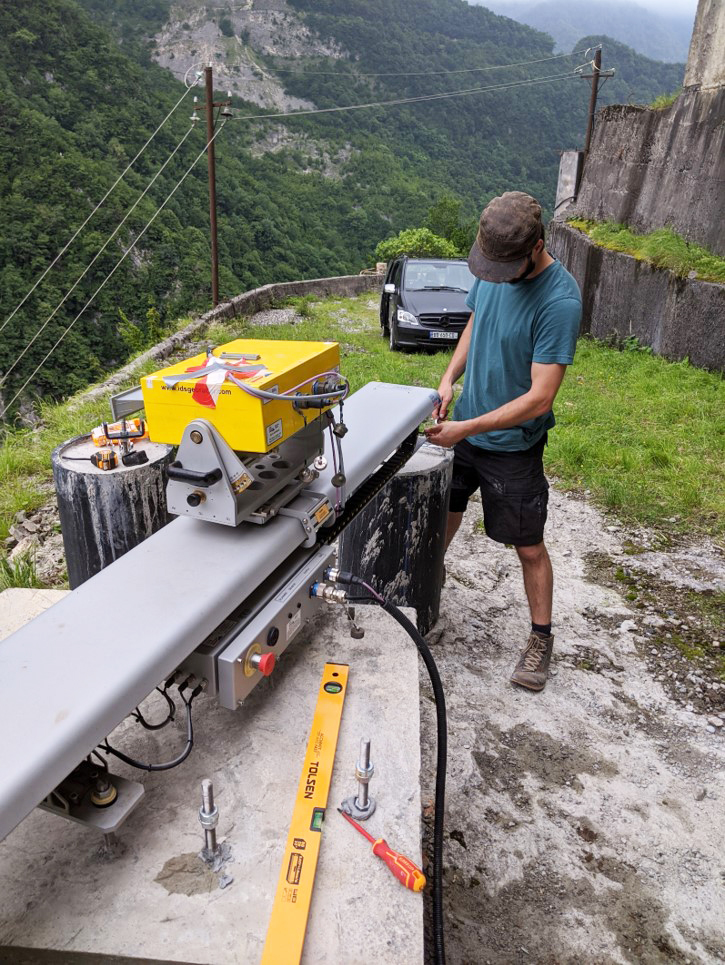 |
Monday, June 21
The borehole has been completed in the afternoon and we installed the Glötzl tool with all the cable in the well until the evening.Then we discussed with the drillers the pumping unit because the expansion cement of Pagel requires a strong pump. The geodetic/photogrammetic team Matthieu and Nils have been preparing the locations for the corner reflectors and especially colored the reflectors with black and white color (some color also has been on the boys).
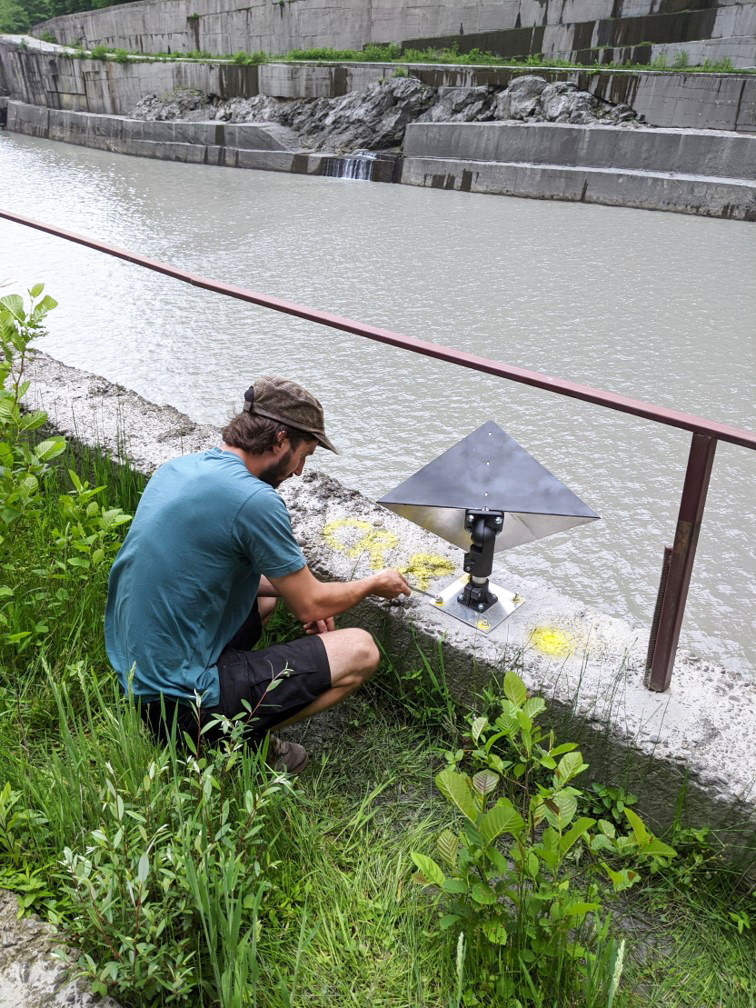 |
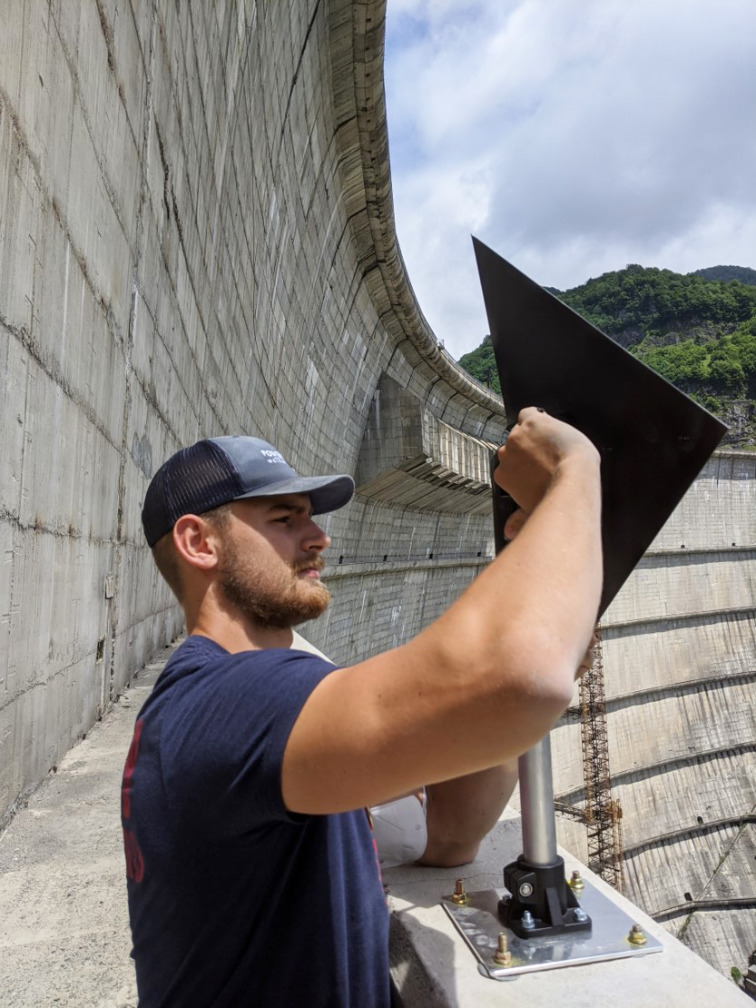 |
Sunday, June 20
In the morning Waldemar Wotschal from Glötzl, Thomas Röckel and Birgit Müller worked in Shtolna-1 tunnel and combined the upper and lower parts of the Glötzl stress monitoring tool and fixed all the tubes at the sonde, set markers for the identification of the reference pressure cell and much more. Finally Waldemar could test each pressure cell and could give the okay, that it is prepared for installation. In the afternoon we had to go for PCR tests into the next village. Drilling of the replacement of Shtolna-1 well is still going on and will take one more day (hopefully not more).
Saturday, June 19
Drilling of Shtolna-2 well has started. In the evening the well was at ca. 9 m depth. We went into the warehouse on the other side of Enguri River. Matthieu and Nils collected all pieces for the installation of the Corner Reflectors and the rest of the team moved the Glötzl Stress Sonde, accessories and 600 kg of Pagel Cement from the warehouse to Shtolna. In the evening we went shopping (not jewelry or clothing, but building material) at Zugdidi. And we also had 2 short cultural stops and in the evening we enjoyed 4:2 Soccer win of the German team.
Friday, June 18
Arrival at 5 a.m. in Tbilisi. Travel from Tbilisi to Enguri Dam. In the late afternoon we went into Shtolna 1 to select the places to store the equipment just before installation and had a brief view on the Jvari Reservoir. Already in Germany we heard that the drilling of an additional well was necessary, because the Shtolna-1 well was not accessible to the final depth. Thus the works to drill Shtolna-2 well have been ordered.
Friday, April 23
Jakob and David used the good weather to drive to stations to build up more corner reflectors. Thomas and I went to the south of Georgia to visit a rather new cascade of HPP in the area of Shuakhevi. We talked with the responsible engineer at the site and could get (without photos) an idea about this HPP system in comparison to Enguri Dam. Also at this site, the power tunnel had been a real challenge.
Thursday, April 22
We went to Abchasia and we really got a unique opportunity because we went into the steel pipes of the penstock area in which the water runs directly to the turbines. Part of these 40 mm thick tubes had to be repaired. We also met our drillers which currently drilled a borehole close to the penstock… oh I wished I would have had Eduard, the winch and the televiewer at the site. Crossing the border takes a long time, so we came back in the evening with some great views into the technique of a giant powerhouse area.
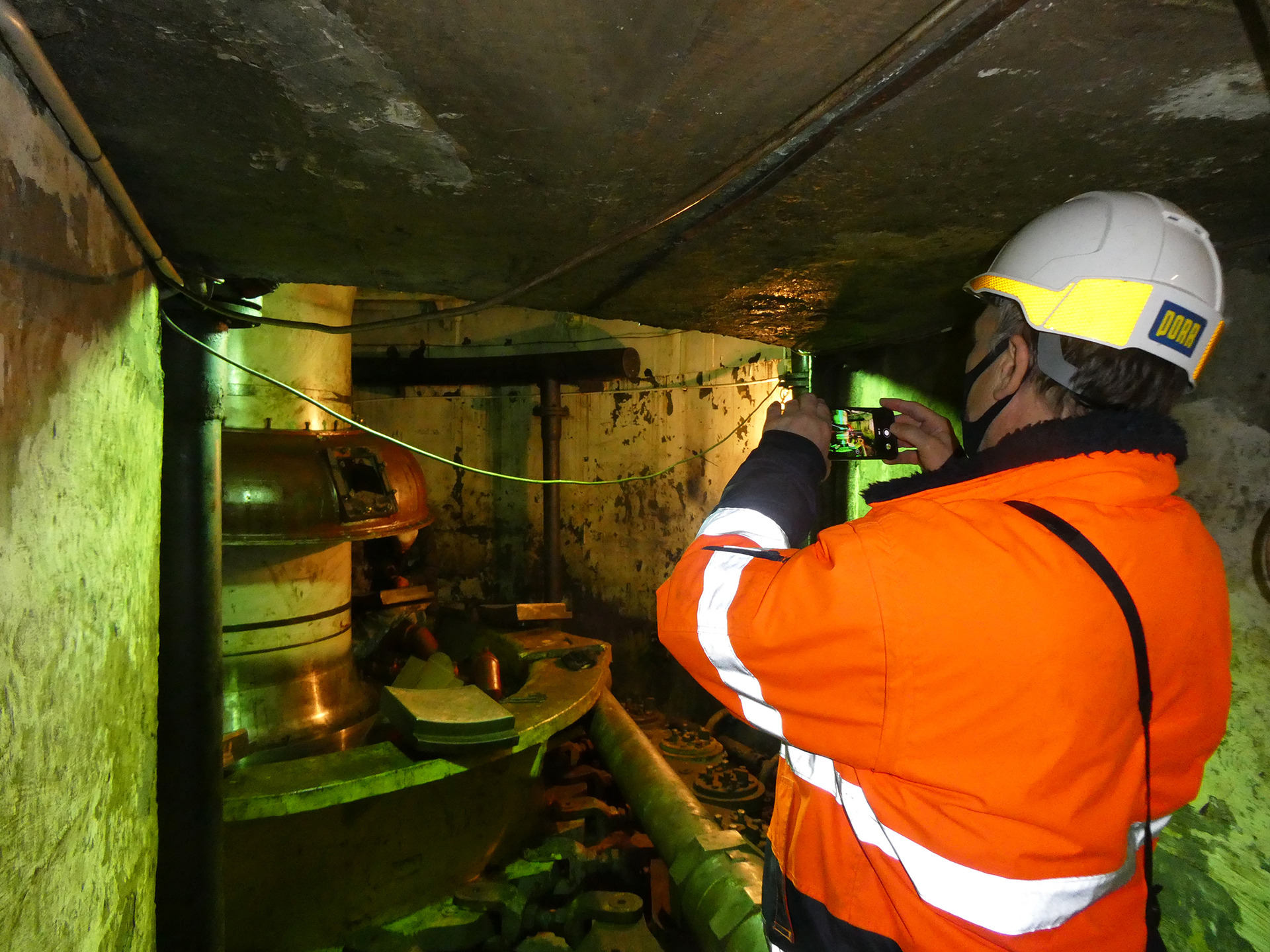 |
 |
Wednesday, April 21
Again Power Tunnel. We tried to measure more structures from adit 4 northward, but after 300 m we could not go on further because ca. half a meter of silt made us get stuck. Thus we returned to adit 1 to prolongate the part which we had been measuring the week before. This time, most of the lights already had been turned off and no rehabilitation activities were going on. So in the absolutely dark tunnel we had to rely on our flash-lights and we hoped that no one will close the big gate when we are in the tunnel. We spent several hours to measure from km 1 to km 2.1.
Tuesday, April 20
Andreas left for Tbilisi after the final check of the GB-SAR. Jakob and David worked on the Corner-Reflectors and Thomas, Birgit and Georgian colleagues took the opportunity to search one of Fritz Rummes Hydraulic Fracturing Boreholes and piles of rocks at the Khudoni location with the means of a metal detector. However, the tool was too weak to find the borehole and we had to go back without success (but being wet). Our Georgian colleagues want to return with a military version of a metal detector... But geologist Thomas was happy because he could measure some of the structures at the Khudoni location.
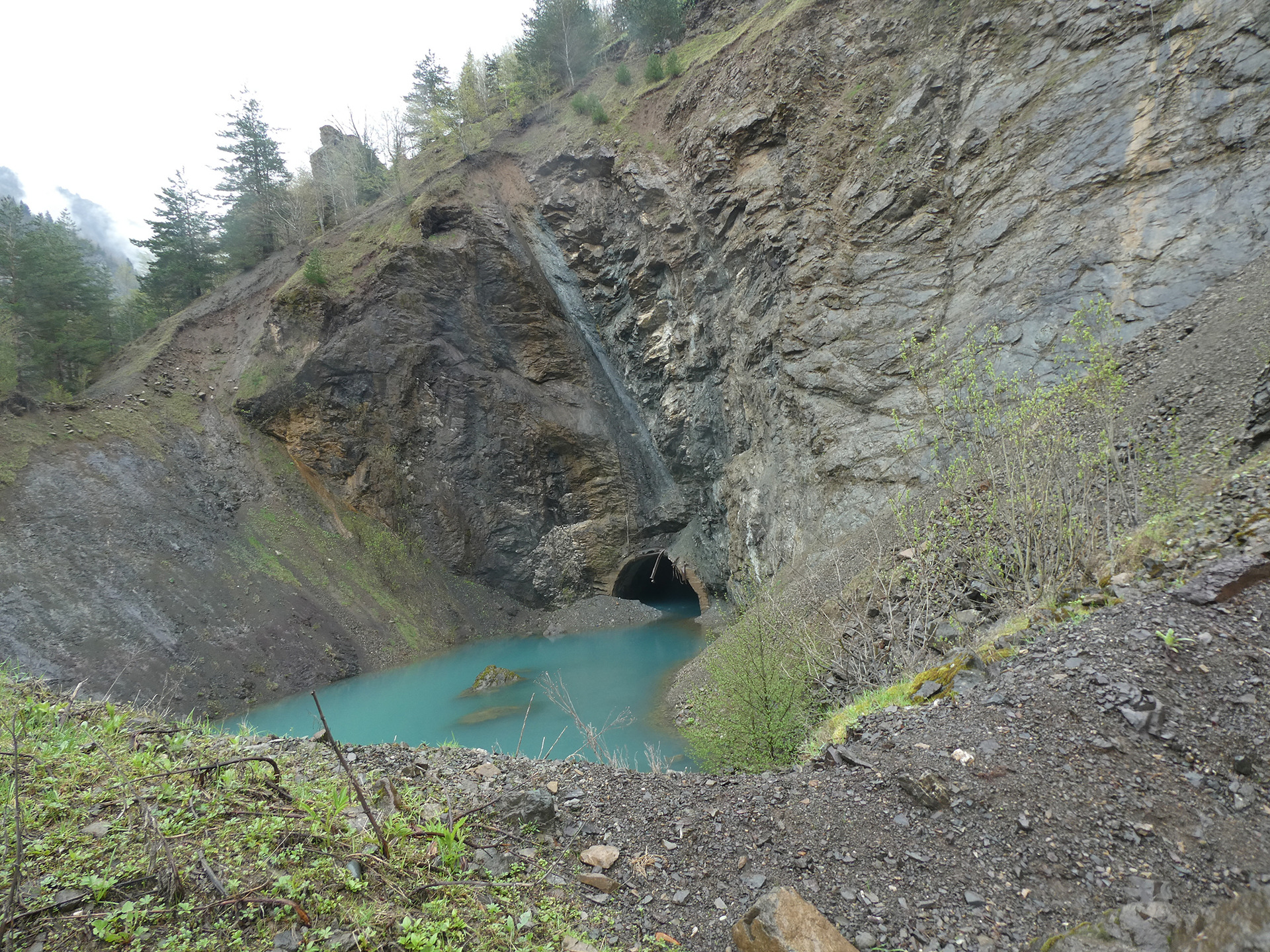 |
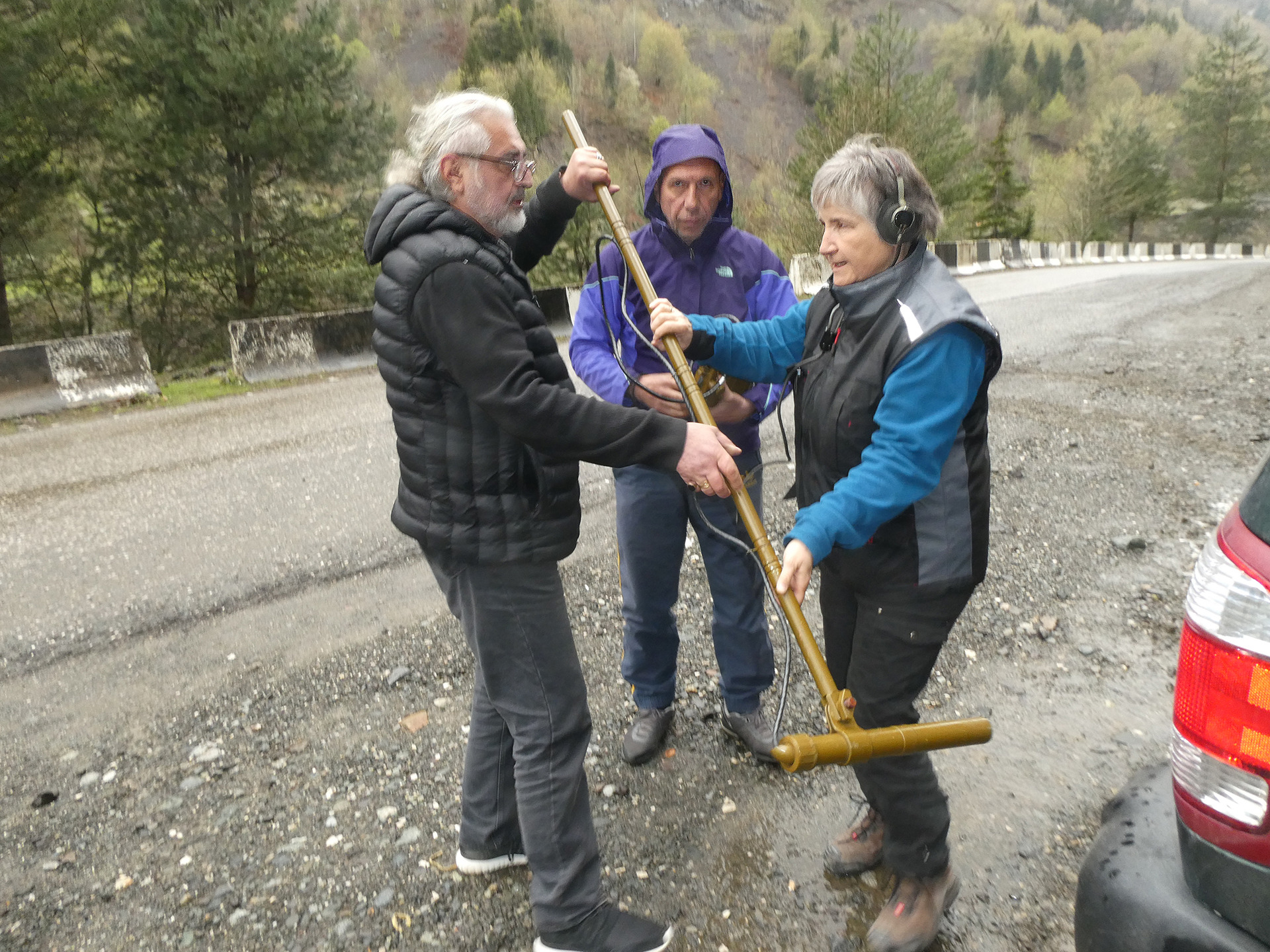 |
Monday, April 19
Together with Jakob from the geodetic team we measured the exact geodetic height of the KIT-1 and the piezometer wellbores. Only one of the wellbores has to be measured with triangulation methods because we got only too few satellites to determine the exact position. Because some of the boreholes had been on the lowest level we came very close to the open gates of Enguri dam and could admire the impressive water flow. In the meantime Andreas Schenk fixed together with David Svandadze and Georgian workers the GB-SAR at the warehouse station.
Sunday, April 18
Again we went into the Power Tunnel. This time for a distance of ca. 5 km from the entry at adit 5. Inside the power tunnel we checked fractures and spalling. Some of the open construction joints could be at orientations of tensile stresses, which had been calculated by PhD candidate Thomas Niederhuber (Team AGW-TP).
Saturday, April 17
On Saturday we provided a presentation for the company Energony who is doing part of the power tunnel rehabilitation works. Afterwards some of us were lifted via a crane and a cage from the top of the dam to the Jvari Reservoir lake. There we measured some points to follow the Ingirishi fault plane…. And we got up again to the dam top… Andreas Kron started his drone to follow our flight. But even colleagues who did not join the crane tour left the surface. Andreas Schenk installed the GB-SAR on the roof of a house at the warehouse site.
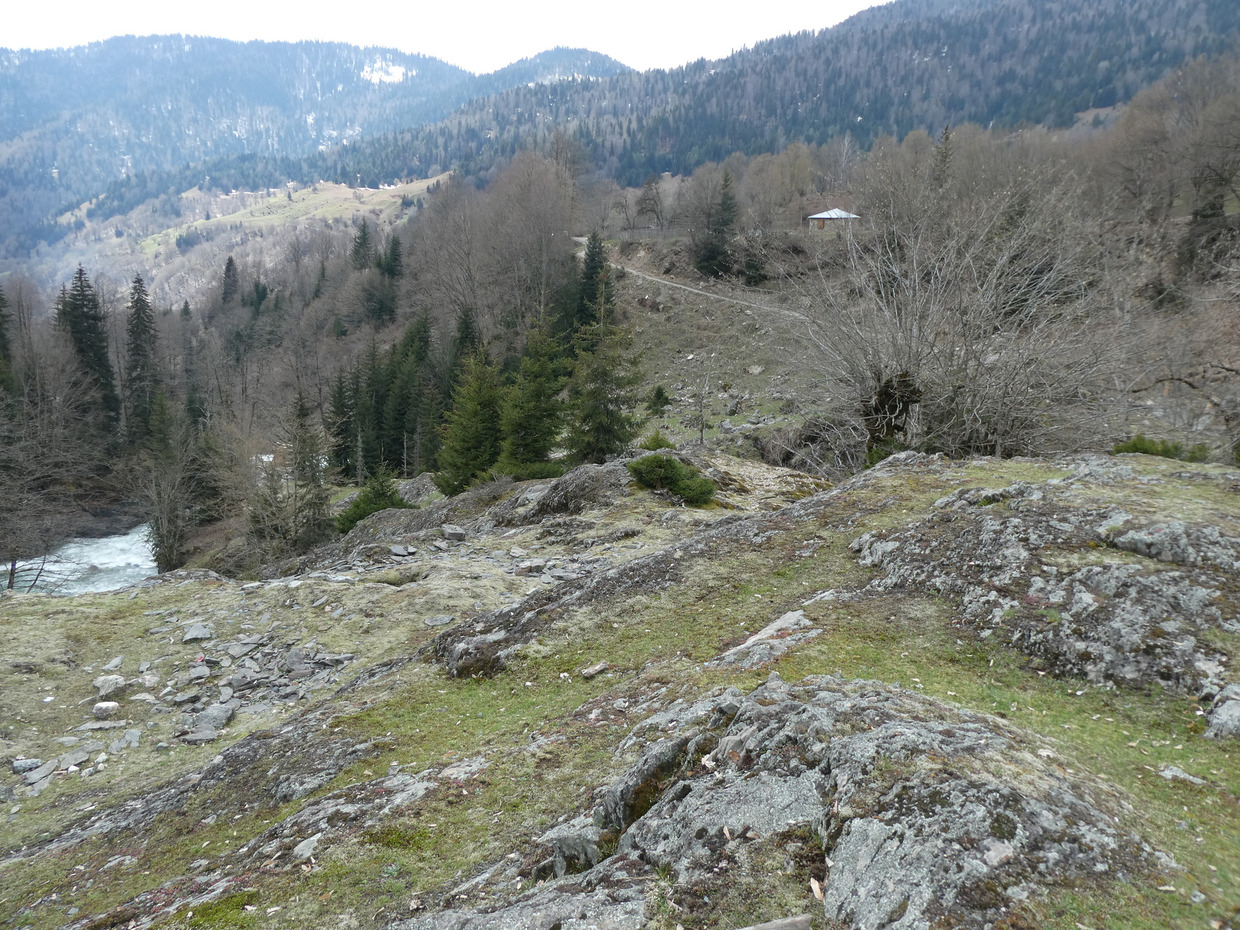
Friday, April 16
Trip to Nenskra valley. The teams of IWG and IPF had been checking the bridges in the Enguri and Nenskra-Valley for the possibilities to install instruments to measure the water flow and the sediment load in the rivers. All colleagues were impressed by the fact that one of the bridges had been damaged by a flood 2 years ago. (P1010082). In the afternoon the teams separated and the AGW-TP and Piewak & Partner went on to search for potential drilling sites in the Nenskra-Valley. This is quite difficult because only in a few places the bedrock reaches the surfaces. In most places the pebbles and rocks transported by the river would be critical for drilling and logging. However, the rocks close to the river provided a nice place for the lunch break.
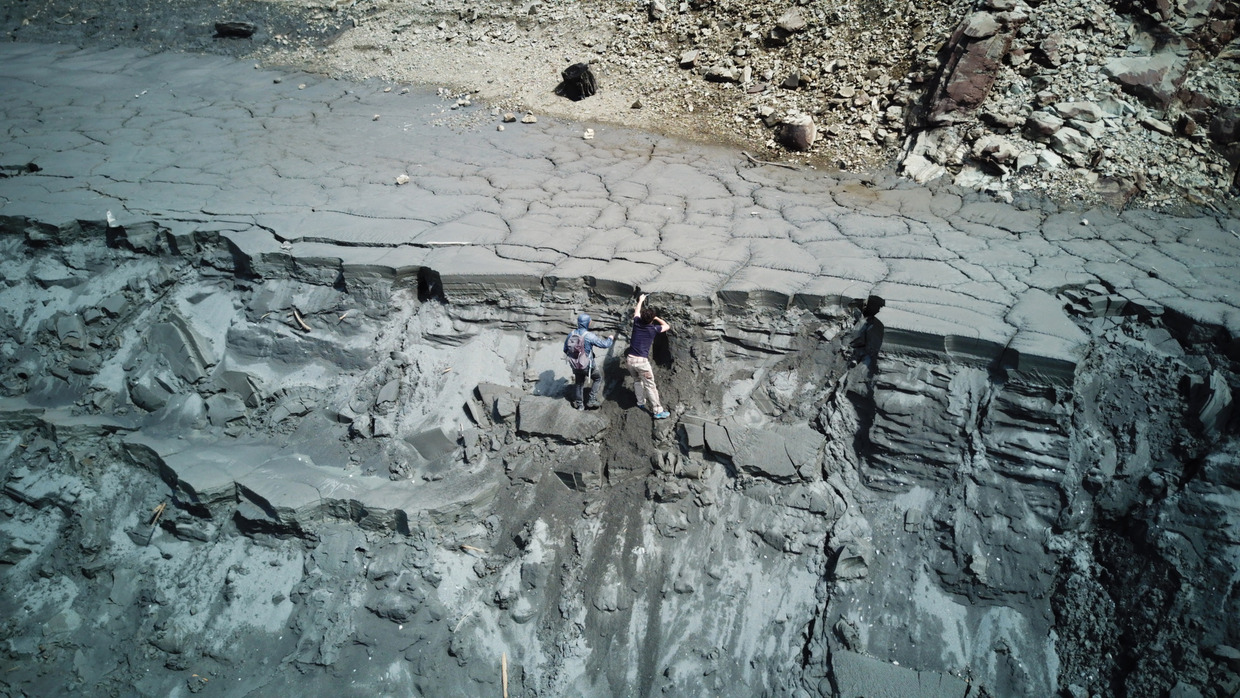
Thursday, April 15
PCR Testing day. In the morning Piewak&Partner and AGW-TP checked for the northern prolongation of the Ingirishi fault. Other colleagues discussed with local builders the forthcoming activities and went shopping (building material).
Wednesday, April 14
The teams at Enguri have been working in the field. The IWG-team was digging at a 10 m high embankment for sediment samples in the centre of the Enguri Valley. At that position the original lake bottom had been crosscut by the river due to the low waterlevel which is required for the Enguri power tunnel rehabilitation works. The colleagues Stephan, Klajdi and Andreas also used a drone which offered some spectacular views. As everybody could imagine the digging at the surface was simple…. But they went down the embankment too. What they could not identify clearly was the remnant boot which they found…may be a lost scientist from an earlier field campaign. IPF built up the GB-SAR at the hotel location and the GIK team checked its equipment to be used in the field the next days. The AGW-TP and Piewak & Partner checked fractures in the power tunnel at adit 1 (close to dam) and adit 2 (Olori Valley) as well as the potential location of the Ingirishi fault in the Olori Valley.
Tuesday, April 13
After having passed the COVID Tests at Munich airport and the night flight, we arrived at around 4:30 a.m. on Tbilisi airport where we picked up cars (Andreas, Andreas, Klajdi, Jakob, Stephan) or got picked-up (Birgit, Thomas) by our Georgian colleagues. In the afternoon we met Mr. Aberle from Energony with whom we discussed the model results of T. Niederhuber for the Power Tunnel. Lateron we had a meeting with Director Joni Chania.

